Étiquette : Quinten Matsijs
Posted by: Karel Vereycken | on août 10, 2024
Quinten Matsys and Leonardo — The Dawn of The Age of Laughter and Creativity
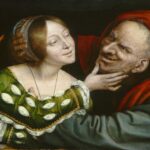
Par Karel Vereycken, August 2024.
Lire cet article en ligne en FR

By Karel Vereycken, August 2024.
Summary
Introduction
A. Making our values great again
- Cynical jokes or Socratic dialogue?
- What is Christian humanism?
- Petrarch and the “Triumph” of Death
- The Age of Good Laughter
- Sebastian Brant, Hieronymus Bosch and The Ship of Fools
B. Quinten Matsys’ Early Life and biography
- From blacksmith to painter
- Duchy of Brabant
- Training: Bouts, Memling and Van der Goes
- Getting started in Antwerp and abroad
C. Selected Works and thematics
- The Virgin and the Child, « Divine Grace » and « Free Will«
- The Saint Anne Altarpiece
- A New Perspective
- Cooperation with Patinir and Dürer
- The Erasmus Connection
- Thomas More’s Utopia
- Pieter Gillis and « The Friendship diptych«
- The Da Vinci Connection (I)
D. The Art of Erasmian Grotesque
- In religious paintings
- Misers, Bankers and Money-changers, the Fight against Usury
- The Da Vinci Connection (II)
- The Art of Grotesque per se
- The metaphor of the “Ill-matched Lovers”
- Leonardo’s baby: “The Ugly Duchess”
E. Conclusion
Selected Bibliography
In the early XVIth Century, Quinten Matsys (1466–1530), emerged as a major painter in Antwerp where he worked for over 20 years creating numerous works, among which profound religious triptychs, amazingly detailed portraits and some of the most hilarious satirical works in the history of painting.
To do honor and do justice to this badly well-known artist, we will explore and highlight here his Erasmian spirit and some of his most mind-provoking artistic contributions.

At the turn of the century, attracting talents from all over the continent as a magnet, Antwerp, and with some 90,000 inhabitants, had become a growing port and trade center, outdoing the Medici’s dominated Brugge in importance.
It was in this environment of a boiling cultural melting-pot that Quinten Matsys met, discussed and collaborated with some of the brightest of the great christian humanists of his time, be it erudite peace activists such as Erasmus of Rotterdam, Thomas More and Pieter Gillis, innovative printers such as Dirk Martens from Aalst, demanding reformers such as Gerard Geldenhouwer and Cornelius Grapheus, Flemish painters such as Gerard David and Joachim Patinir or foreign engravers as Albrecht Dürer, Lucas van Leyden and Hans Holbein the Younger.
Unfortunately, today, large international publishing houses, such as Taschen, for reasons yet unclear, seem to have condemned this highly remarkable artist to oblivion. For all those reasons, one finds hardly mention of Matsys’ name. It only appears in a short chapter dealing with the “Antwerp school”, at the end of Les Primitifs flamands et leur temps (656 pages, Renaissance du Livre, 1994). Even worse, not a single of his works is presented and only two mentions of his name appear in L’art flamand et hollandais, le siècles des primitifs (613 pages, Citadelles et Mazenod, 2003).
The good news is that since 2007, the Ghent Interdisciplinary Centre for Art and Science is working on a new « catalogue raisonné » of his work. That of Larry Silver (Phaedon Press, 1984) is mostly unavailable or/and became largely unaffordable. What remains is the one of Andrée de Bosque (Arcade Press, Brussels, 1975), with very few color prints. As a consolation, readers can access Harald Brising’s 1908 doctoral thesis, in a reprint version of 2019.
To honor and do some justice to this artist, we will attempt to explore in this article some questions left unanswered so far. To what extent did Erasmus’ work directly inspired Matsys, Patinir and their circle? What do we know about the exchanges between this group and prominent Renaissance artists such as Leonardo da Vinci and Albrecht Dürer? What influence did the Erasmian artist exert on his foreign correspondents? Erasmus wasn’t really a fan of what was called “religious” paintings in those days, preferring agapic action for the common good to passive devotion of holy images.
As Belgian art critic Georges Marlier (1898-1968) pointed out in 1954, in his well documented book, while Erasmus respected and honored holy paintings if they evoked real religious sentiment, love and tenderness, that didn’t prevent him from thinking that:
“the real imitation of Christ and his Passion consists in mortifying the leanings that are warring against the mind rather than whining about the Christ as if it were an object of pity.” (p. 163)
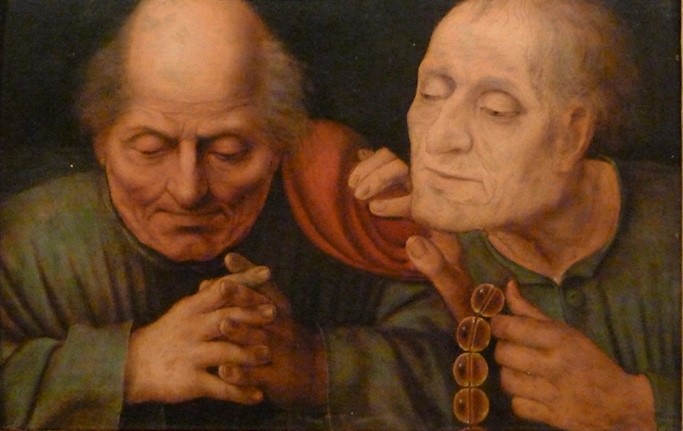
Our previous inquiries into the works of both Erasmus and Dürer have familiarized us with Matsys’ age and its challenges, a subject we can not redevelop here at full length, but which gives the author some solid grounds to accomplish this task.
A. Getting our values straight
1. Cynical jokes or Socratic dialogue?

Many modern viewers, with untrained eyes and minds steeped in a culture of abusive wokism and pessimism, lack the moral and intellectual integrity to understand the jokes, irony and metaphors which were the very essence of cultural life in the Low Countries of that time.
Lost in their own cultural prejudices, in looking at a painted face, they miss the visual puns the artist is making, trying instead to establish its identity as if the subject was a portrait. They pay obsessive (eventually useful) attention to “secret” and symbolic meanings of iconographic details hoping that their sum will somehow allow them to arrive at a sort of meaning.
We will look here afresh at Erasmus’, Matsys’ and Leonardo’s “grotesques,” which are not “cynical jokes” showing a “lack of tolerance” towards “ugly”, “sick”, “abnormal” or “different” people, as the accusation goes, but caricatures and jokes aimed to free our minds!
Erasmus and his three main followers Rabelais, Cervantes and Shakespeare, are the real if rarely recognized incarnations of “Christian humanism” and good laughter as a powerful political weapon to educate people’s characters, was not yet outlawed at their time.
2. What is Christian Humanism?
The thrust of Erasmus‘ educational and political programme was the promotion of docta pietas, learned piety, or what he termed the “Philosophy of Christ”. It can be summarized as a “wedding” between the humanist principles summarized in Plato’s Republic and the agapic notion of man transmitted by the Holy scriptures and the writing’s of those early fathers of the Church as Jerome and Augustine who saw Plato as their imperfect precursor.
In a complete phase shift and break with feudal “blind” faith putting man’s hope uniquely in his salvation by Christ in a putative existence after death, for christian humanism, man’s nature is good and therefore the origin of evil is not man himself or some outside “Devil”, but those vices and moral afflictions Plato basically identified in his Republic centuries before being turned by the christian humanists into the famous “Seven Capital Sins” that had to be overcome by the “Seven Capital Virtues.”

As a reminder, these deadly sins are:
- Pride, (Superbia, hubris) as opposed to Humility (Humilitas);
- Greed (Avaricia) as opposed to Charity (Caritas, Agapè);
- Wrath (Ira, rage) as opposed to Patience (Patientia);
- Envy (Invidia, jealousy) as opposed to Kindness (Humanitas);
- Lust (Luxuria, fornication) as opposed to Chastity (Castitas);
- Gluttony (Gula) as opposed to Temperance (Temperantia);
- Sloth (Acedia, melancholy, spleen, moral laziness) as opposed to Diligence (Diligentia).
Isn’t it quite telling for our own times that these sins (affections preventing us from doing the good), and not their opposing virtues, have tragically been consecrated as the very basic values guaranteeing the well-functioning of the current “Neo-liberal” financial system and its « rules-based » world order!
“Private vices make public virtue”, argued Bernard Mandeville in his 1705’s The Fable of the Bees. It is the dynamics of particular interests that stimulate the prosperity of a society, according to this Dutch theorist who inspired Adam Smith, and for whom “morality” only invites lethargy and provokes the misfortune of the city.
It is greed and perpetual pleasure-seeking and not the Common Good that have been proclaimed to be man’s essential motives, according to the dominant school of British Empiricism: Locke, Hume, Smith and consorts.
“Charity,” “Care” and “Humanitarian” aid have been reduced to a despicable and increasingly rare Lady-do-rightly activity allowing the current system to perpetuate its criminal existence. Oligarchical and banking families’ “charities” and “foundations” have even become the oligarchy’s tool to impose their perpetual dominance.
3. Petrarch and the “Triumph of Death”
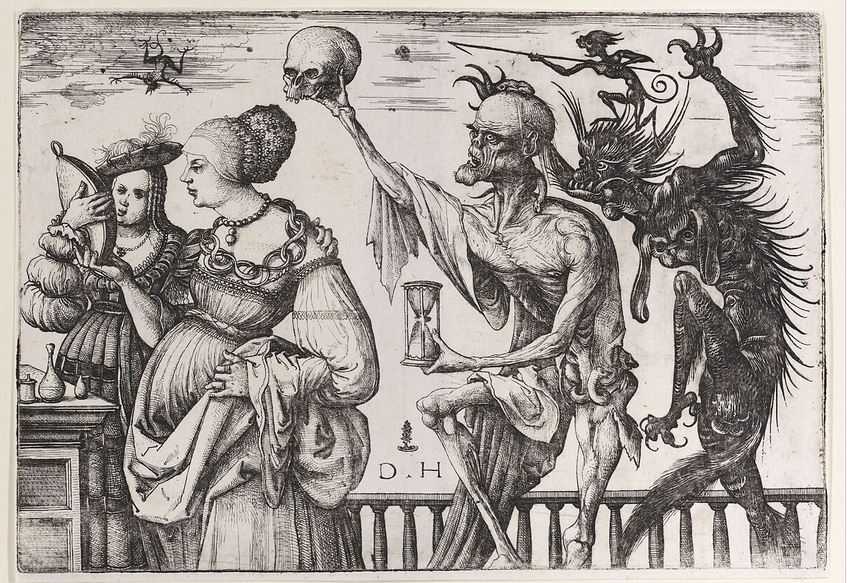
Christianity, as all major humanist religions, relentlessly labor to shake up those wasting their lives in sinful behavior by showing them how their behavior is both dramatic and even ridiculous in light of the extreme shortness of individual physical existence.
Dürer made this the core theme of his three famous Meisterstiche (master engravings) who have to be interpreted and cannot be understood but as one single unity: Knight, Death and the Devil (1513), Saint Jerome in His Study (1514) and Melencolia I (1514).

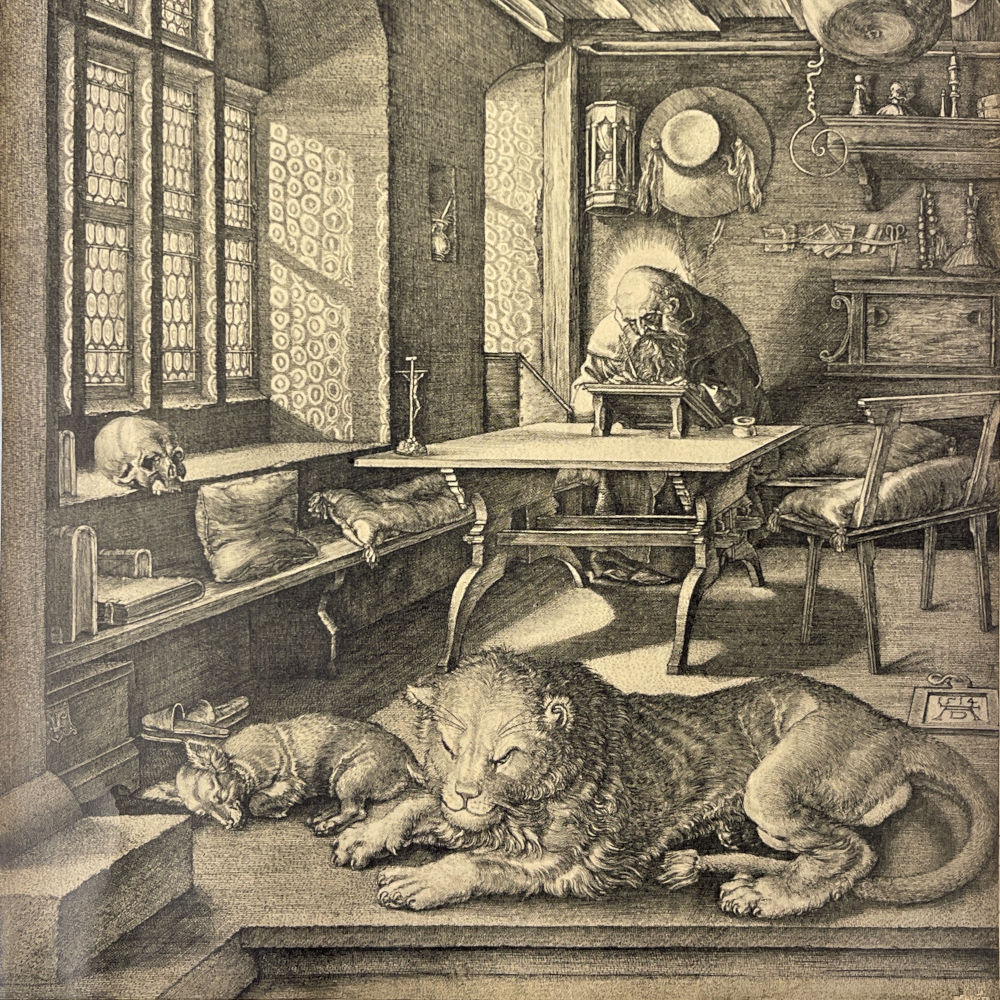

In each of these engravings one can find an hourglass, metaphor for the inexorable march of time. Saint Jerome is often depicted with an hourglass (time) and a skul (mortality), a metaphor for vanitas. Erasmus made of these concepts his personal banner together with the moto: “Concedi Nulli » which refers to death saying that nobody will escape her grip, underlining even more the inexorable nature of human mortality. In that sense, the Christian Renaissance, was a mass movement for spiritual immortality, both against religious superstition and against the revival of Greco-Roman paganism.
This conceptual theme was congruent with Francis Petrach’s (1304-1374) poetic I Trionfi cycle (1351-1374), structured in six allegorical triumphs.

Petrarch’s triumphs are “concatenated,” so that the Triumph of Love (over Mankind and even Gods) is itself triumphed over by another allegorical force, the Triumph of Chastity. In its turn, Chastity is triumphed over by Death; Death is overcome by Fame; Fame is conquered by Time; and even Time is ultimately overcome by Eternity, the Triumph of God over all such worldly concerns.
Since death will “triumph” at the end of our ephemeral physical existence, the fear of death and the fear of God should help man concentrate to contribute something immortal to future generations rather than get lost in the labyrinth of earthly pleasures and pains that Hieronymus Bosch’s (1450-1516) depicted with great irony in his Garden of Earthly delights (1503-1515), .
Leonardo, whose far advanced scientific-religious sentiment was considered a heresy by many in Rome, expressed with some anger in his notebooks that many men and women didn’t merit the beautiful human body God gave them.
“How many people there are who could be described as mere channels for food, shit factories, fillers of latrines, for they have no other purpose in this world; they do nothing even remotely worthwhile; all that remains after them is a load of shit.”
4. The Age of “Good Laughter”
Dictionaries have it that people have a “good laugh” when they find amusing and funny a situation that was at first upsetting. In short, good laughter is the reward of a true creative process when the “agony” of looking for solutions ends with finding one. That can be for scientific and practical questions but also in the development process of one’s personal identity. The storm and the clouds are gone and full light brings a new perspective.

For the Christian humanists, through the “mirror-effect” intrinsically inherent to a “Socratic dialogue” (which starts by accepting what you know not – called docta ignorantia by Cusanus), man has and can be freed from these “sinful” afflictions, because man’s free will can be mobilized to bring him to act in accordance to his real (good) nature, that of dedicating himself and getting his ultimate pleasure in accomplishing the common good in service of the others, including in economic activities.
By claiming that man’s life on earth is fully predetermined by God, Luther’s denied the existence of the free will, and made man totally irresponsible for his own deeds. That viewpoint was the exact opposite of that of Erasmus who had started calling on the Church to curb their financial abuses such as the famous “indulgencies” longtime before Luther was brought on the scene.

The Christian Humanists were firmly committed to elevate our souls to the highest realm of moral and intellectual beauty by freeing us from our earthly attachments — not by inflicting guilt feelings or moral orations and the lucrative business of fear from hell, but by laughter!
Laughter can ruin the authority of the powerful and the tyrants. Therefore, it is the most devastating political weapon ever conceived. For the evil forces, truth-seeking laughter, of the sort promoted by Erasmus and his followers, had and remains to be ignored, slandered and as much as possible eradicated and replaced with melancholy, obedience and submission to in advance justified narratives and doctrines of painful scholastic constipation.
5. Sebastian Brant, Hieronymus Bosch and The Ship of Fools


Years before Erasmus published his In Praise of Folly (written in 1509 and first published in Paris in 1511), the Strasbourg humanist poet and social reformer Sebastian Brant (1558-1921), opened the of the gates of such Socratic laughter with his Narrenshiff (The Ship of Fools, published in 1494 in Basel, Strasbourg, Paris and Antwerp), a hilarious satirical work illustrated with engravings of Albrecht Dürer (1471-1528) and later Holbein the Younger (1497-1543). 73 of the 105 illustrations for the original edition were produced by Dürer.
Brant was a key contact and ally of Johann Froben (1460-1529) and Johann Amerbach (1441-1513), the Swiss printer families that later welcomed Erasmus when being persecuted in the Low Countries he had to go into exile in Basel.
The Ship of Fools took Europe by a storm. Brant was not only a satirist but a well educated humanist who had notably translated Petrarch’s poems.
“Genre-painting,” wrote Georges Marlier in 1954 and more recently the American art historian Larry Silver, depicting aspects of everyday life by portraying ordinary people engaged in common activities, was born with Quinten Matsys (One should rather say with the Erasmian paradigm we just identified).


Images of more ordinary women and men, wealthy tradesman and bankers, suddenly appeared as sovereign individuals to be portrayed for their own merits rather than as donors praying while assisting at a religious scene. Dürer made an engraving of « a cook and his wife. »
Of course, times had changed and so had the client-base of painters. The orders came much less from the religious orders and wealthy cardinals in Rome and increasingly more from wealthy bourgeois out to embellish their homes and eager to offer their portraits to friends.
The expansion of the Antwerp market that made paintings available as a middle-class luxury product is a well-studied phenomenon, and research has confirmed Ludovico Guicciardini’s claim that there were at least 300 active painters’ workshops in Antwerp by the 1560s.
Brant’s Ship of Fools, was a real turning point and game changer of the day, the prelude of a new paradigm. It marked the beginning of a long arch of creativity, reason and education through healthy laughter whose echo resonated loudly until the death of Pieter Bruegel the Elder in 1569. That élan was ony halted when Charles Vth resurrected the Inquisition in 1521 by plublishing his decrees (“placards”) forbidding ordinary citizens from reading, commenting and discussing the Bible.

The Ship of Fools is divided in 113 sections, each of which, with the exception of a short introduction and two concluding pieces, treats independently of a certain class of fools or vicious persons; and we are only occasionally reminded of the fundamental idea by an allusion to the ship. No folly of the century is left uncensored. The poet attacks with noble zeal the failings and extravagances of his age, and applies his sword unsparingly even against the dreaded Hydra of popery and monasticism.
The book opens with the denunciation of the first fool, one which turns away from the study of all the wonderful books in his possession. The third one (out of 113), not far away, is greed and avarice.
Coherent with this, is Hieronymus Bosch’s partly lost triptych. Modern research has established that Bosch’s Ship of Fools (Louvre, Paris), eventually painted before Brant wrote his satire, was the left panel of a triptych whose right panel was The Death of the Miser (National Gallery, Washington).
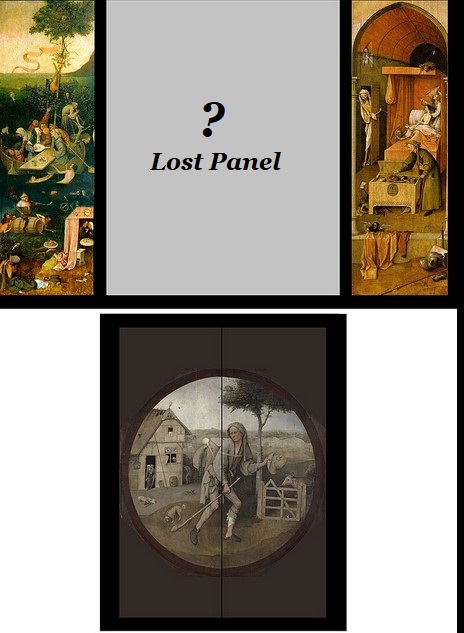
Interesting here, is the fact that there is no fatality in this painting and that what people become, a fool or a wise man, depends on each person’s personal decision, a doctrine quintessential to the convictions of the Brothers of the Common Life with whom Bosch, without being a member, had major affinities. Even the miser, until his last breath, can choose between looking up to Christ or down to the devil!
We ignore the theme of the central panel which is lost. But we do know that the backsides of the two lateral panels folded together complete the image of a Door-to-door salesman (before mistakenly called The return of the prodigal son) also depicted on the outside panels of Bosch’s triptych of the Hay wagon, showing kings, princes and popes running after a wagon full of hay (a metaphor for money).
The theme of a peregrinating peddler was very popular among the Brothers of the Common Live and the Devotio Moderna for whom individual responsibility and choice was decisive for each person to save above all himself with some help of God.
For Augustine, man is permanently confronted with an existential choice. Either he takes the bumpy, difficult road moving him to a spiritually more elevated position and closer to God, or he goes down the easy way by attaching himself to earthly passions and affections. The beauty of man and nature, warns Augustine, can and should be fully enjoyed and celebrated under condition they are understood as a mere “foretaste of divine wisdom” and not as purely earthly pleasures. The peddler as found in Bosch and Patinir is therefore a metaphor of mankind fighting to remain on the right road and in the right direction.
Bosch will populate his paintings with deprived men and women running like brainless animals behind little fruits as cherries and beys, metaphors for extremely ephemeral earthly pleasures unable to offer any real durable satisfaction.
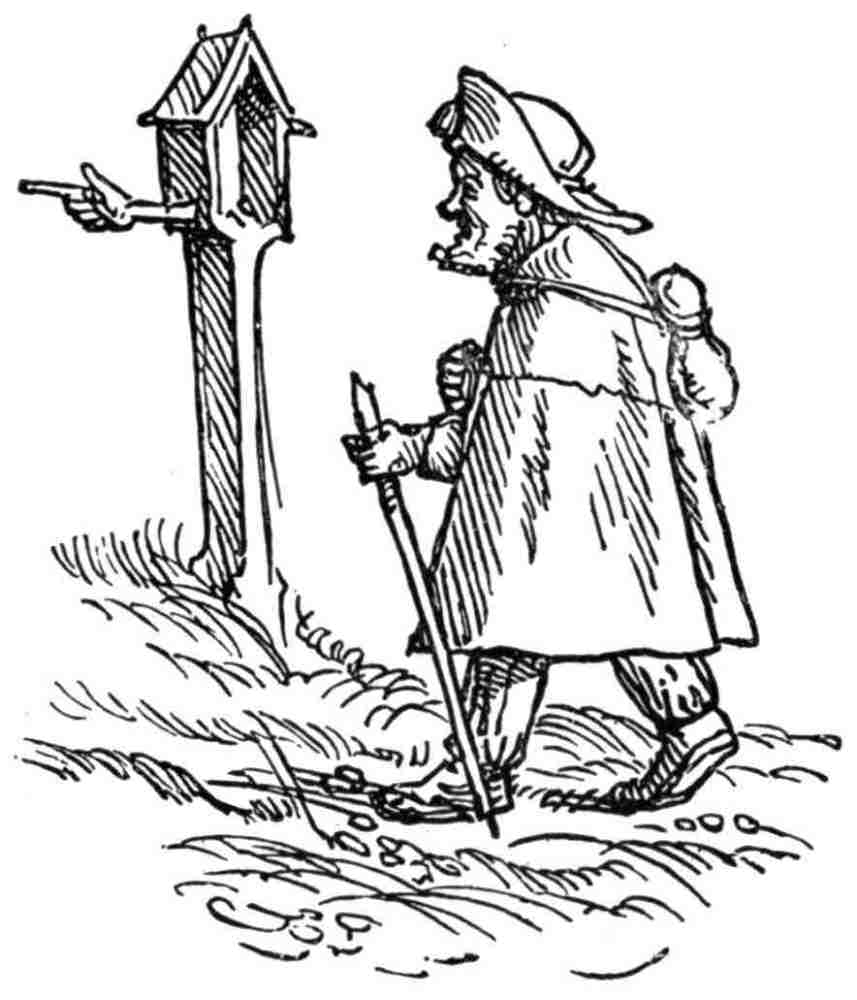
The peddler advances “op een slof en een schoen” (on a slipper and a shoe) i.e., he has abandoned his house and has left the created world of sin (we see a bordello, drunkards, etc.), and all material possessions. With his “staff” (a symbol of Faith) he succeeds in repelling the “infernal dogs” (Evil) that try to hold him back. Such metaphorical images are not personal outbursts of the exuberant imagination of Bosch, but a common image very much used in that period. An illumination of a fourteenth-century English psalm book, the Luttrell Psalter, features exactly the same allegorical representation.
The same theme, that of a homo viator, the man who detaches himself from earthly goods, is also recurrent in the art and literature of this period, particularly since the Dutch translation of Pèlerinage de la vie et de l’âme humaine (pilgrimage of life and the human soul), written in 1358 by the Norman Cistercian monk Guillaume de Degulleville (1295-after 1358).
If the three surviving images on the panels of the Bosch triptych (the Ship of fools, the Miser and the Peregrinating peddler) are hard to connect when analysed separately, their coherence appears strongly once one identifies this overriding concept.
Today, an imaginative, creative painter could try to find out what Bosch’s lost panel would have looked like, the theme certainly having focused on the origin of evil (going from a ship of fools to the death of the miser).
B. Quinten Matsys, biographical elements
With this in mind, and knowing what were the stakes at that time, we can now examine more profoundly Matsys’ life and some of his works.
1. From Blacksmith to painter
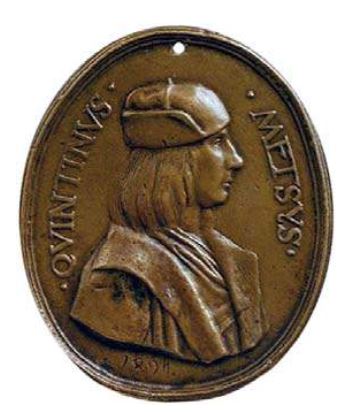
One of four children, Quinten Matsys was born in Leuven to Joost Matsys (d. 1483) and Catherine van Kincken sometime between April 4 and September 10, 1466. Most early accounts of Matsys’ life are composed primarily of legends and very little contemporary accounts exist of the nature of his activities or character.
According to the Historiae Lovaniensium by Joannes Molanus (1533-1585), Matsys was born in Leuven between April 4 and September 10, 1466, as one of four children of Joost Matsys (d. 1483) and Catherine van Kincken.
Most accounts of his life blend fact and legend. In reality, there are very few clues as to his activity or character.
In Leuven, Quinten is said to have had modest beginnings as an ironworker. Legend has it that he fell in love with a beautiful girl who was also being courted by a painter. As the girl much preferred painters to blacksmiths, Quentin quickly abandoned the anvil for the paintbrush.
In 1604, chronicler Karel Van Mander states that Quintin, stricken with an illness since the age of twenty, “was in the impossibility to earn his bread” as a blacksmith.
Van Mander reminds us that in Antwerp, during « Shrove Tuesday » celebrations,
“… the brothers who cared for the sick would go around town, carrying a large carved and painted wooden torch, distributing engraved and colored images of saints to the children; so they needed a large number of them. It so happened that one of the confreres went to see Quentin and advised him to color some of these images, with the result that Quentin tried his hand at the job. From this tiny beginning, his talent became apparent, and from then on he began to paint with great enthusiasm. In no time at all, he made extraordinary progress and became an accomplished master.”
(Karel Van Mander, The Book of Painters, 1604)


In Antwerp, in front of Our Lady’s cathedral at the Handschoenmarkt (glove market), one still can find the « putkevie » (a decorated wrought iron gate on a well) said to be made by Quinten Matsys himself and depicting the legend of Silvius Brabo and Druon Antigoon, respectively the names of a mythical Roman officer who liberated Antwerp from the oppression of a giant called Antigoon who would harm the trade of the city by blocking the entrance of the river.
The inscription on the well reads: “Dese putkevie werd gesmeed door Quinten Matsijs. De liefde maeckte van den smidt eenen schilder.” (« The ironwork for this well was forged by Quinten Matsys. Love made the blacksmith a painter. »)
Documented donations and possessions of Quinten’s father Joost Matsys indicate that the family had a respectable income and that financial need was not the most likely reason for which Matsys turned to painting.

Although no evidence exists documenting Quinten Metsys’ training before his enrolment as a free master in the Antwerp painter’s guild in 1491, his brother Joos Matsys II’s design project in Leuven and their father’s activities suggest that the young artist first learned how to draw and transfer his ideas to paper from his family and that they first exposed him to architectural forms and their creative deployment.
His earlier works in particular clearly suggest that he had training as an architectural draughtsman. In his 1505 Virgin and Child Enthroned with Four Angels, the divine titular characters are seated on a gilded throne whose gothic tracery echoes that in the window on the parchment drawing and the limestone model for the St Peter’s project to which his brother was assigned at around the same time.
In 1897, Edward van Even, without presenting any evidence, wrote that Matsys also composed music, wrote poetry and produced etchings.

What we do know for sure is that the artist produced some magnificent bronze medaillons representing Erasmus, his sister Catarina and himself.
Around 1492, he married Alyt van Tuylt, who gave him three children: two sons, Quinten and Pawel, and a daughter, Katelijne. Alyt died in 1507 and Quentin remarried a year later. With his new wife Catherina Heyns, they had ten more children, five sons and five daughters. Shortly after their father’s death, two of his sons, Jan (1509-1575) and Cornelis (1510-1556), became painters and members of the Antwerp Guild.
2. The Duchy of Brabant

Leuven, at that time, was the capital of the Duchy of Brabant which extended from Luttre, south of Nivelles to ‘s Hertogenbosch. It included the cities of Aalst, Antwerp, Mechelen, Brussels and Leuven, where in 1425, one of the first universities of Europe saw the light.
Five years later, in 1430, together with the Duchies of Lower Lotharingia and Limburg, Brabant was inherited by Philip the Good of Burgundy and became part of the Burgundian Netherlands.
Then, when Matsys was around 11 years old, in 1477, the Duchy of Brabant fell under Hapsburg rule as part of the dowry of Mary of Burgundy to Spanish king Charles V.
The subsequent history of Brabant is part of the history of the Hapsburg « Seventeen Provinces » increasingly under the control of such Augsburg banking families as the Fuggers and Welsers.
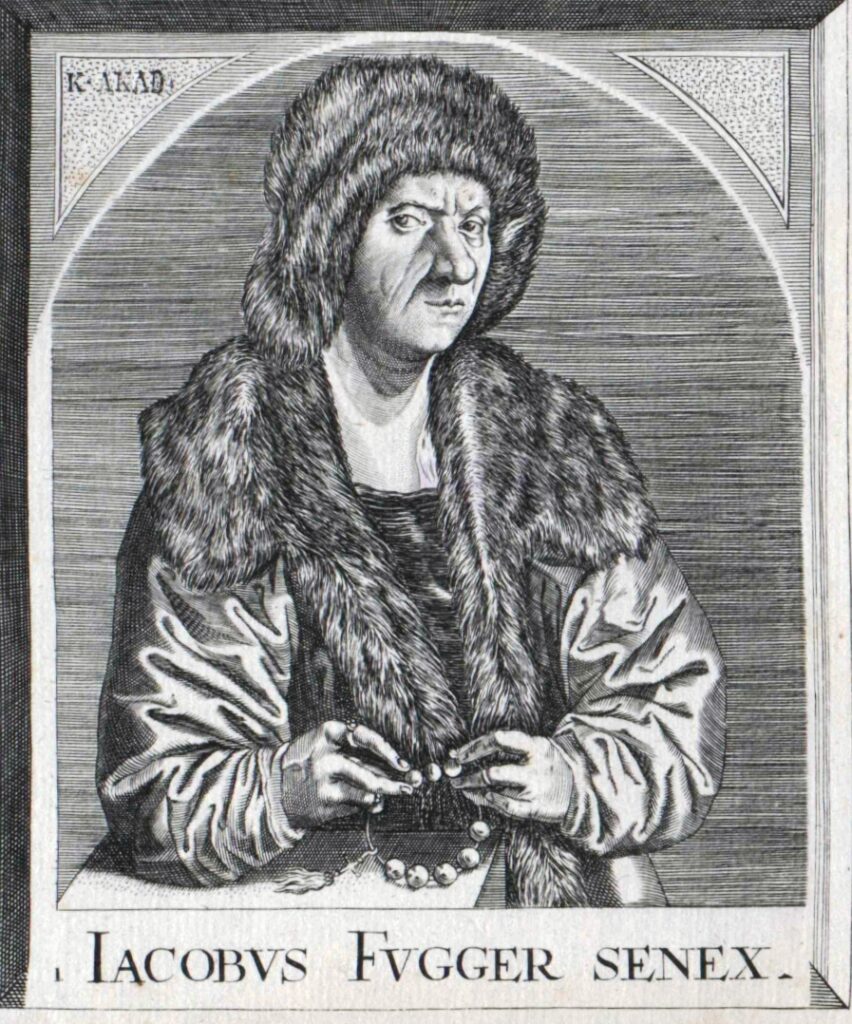
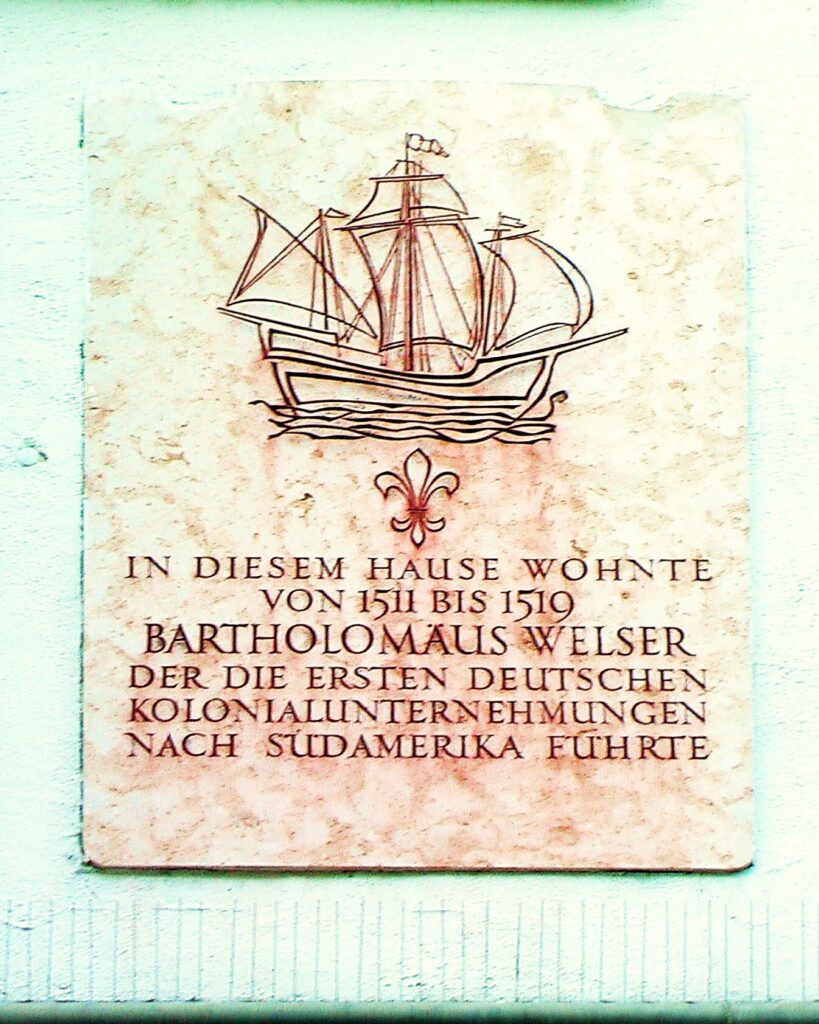
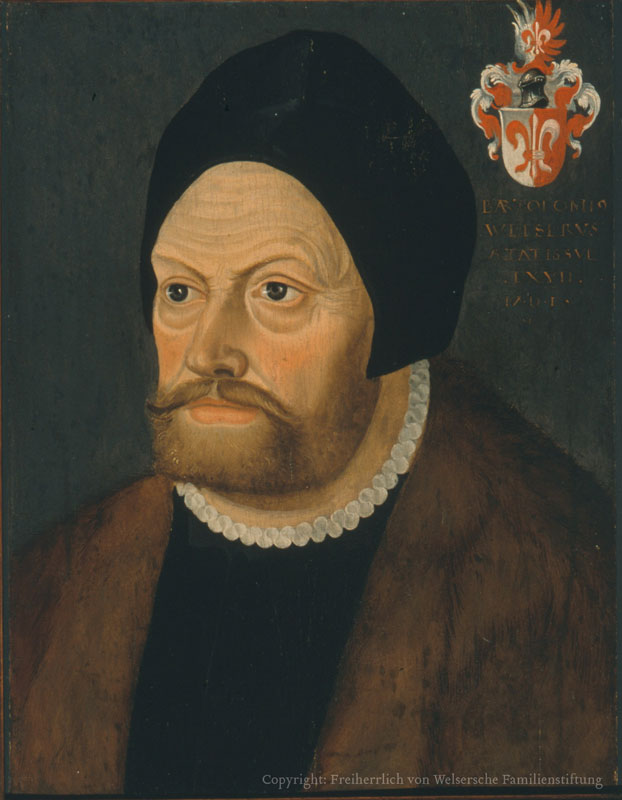
Erasmus and Matsys epoch was a glorious period of the “Renaissance in the North” but also marks the continuous efforts of these banking families’ to “buy up” the papacy and achieve world hegemony. The imperial geopolitical sharing of the entire world among the Spanish Empire (run by Venetian and Fugger bankers) and the Portuguese Empire (run by Genovese and Welser bankers), a deal formalized by the Treaty of Tordesillas, endorsed in 1494 in the Vatican by Pope Alexander VI Borgia, opened the gates to colonial subjugation of people and countries, fueled by a highly questionable sense of cultural superiority.
Following the never-ending state bankruptcies of these financial oligarchs, the Low Countries fell prey to economic looting, military dictatorship and fanaticism. By demonizing Luther, increasingly committed to creating an opposition outside the Catholic church, the oligarchy avoided successfully those urgent reforms called for by the Erasmians to eradicate abuses and corruption inside the Catholic church. Rome’s refusal to accept Henry VIII’s demands for divorce, were part of an overall strategy to plunge the entire European continent in “religious wars,” that only ended with the 1648 Peace of Westphalia.
3. Training: Bouts, Van der Goes and Memling
The early triptychs, painted by Matsys, gained him a lot of praise and got historians to present him as one of the last “Flemish Primitives”, in reality a nickname given by Michelangelo to intrinsically slander and discredit all non-Italian art considered “Gothic” (barbarian), or “primitive” in comparison to Italian art whichh immitated the immortal antique style.
Since he was born in Leuven, it has been thought he could have been trained by Aelbrecht Bouts (1452-1549), the son of painter dominating Leuven at that time, Dieric Bouts the Elder (v. 1415-1475).
In 1476, one year after his father’s death, Albrecht reportedly left Leuven, perhaps to complete his training with a master outside the city, most probably Hugo van der Goes (1440-1482), whose influence on Aelbrecht Bouts, but also on Quinten Matsys, seems to have been direct.
Van der Goes, who became the dean of the Painting guild of Ghent in 1474 and died in 1482 in Red Cloister close to Brussels, was a vehement follower of the Brother’s of the Common Life and their principles. As a young assistant of Aelbrecht Bouts, and getting training from Van der Goes, Matsys could have discovered what was the cradle of Christian humanism at that time.
Van der Goes‘s most famous surviving work is the Portinari Triptych (Uffizi, Florence), an altarpiece commissioned for the church of Sant’Egidio in the hospital of Santa Maria Nuova in Florence by Tommaso Portinari, the manager of the Bruges branch of the Medici Bank.
The raw features of the shepherds (expressing the three states of spiritual elevation identified by the Brothers of the Common Life) in van der Goes’s composition made a deep impression on painters working in Florence.

Matsys is also considered as a possible pupil of Hans Memling (1430-1494), the latter being a follower of Van der Weyden and a leading painter in Brugge.
Memling’s style and that of Matsys, in certain aspects, are hard to distinguish.
While the Flemish art historian Dirk de Vos inscribed, in his 1994 catalogue of Hans Memling’s work, the portrait of the musician and composer Jacob Obrecht (1496, Kimbell Art Museum, Fort Worth), as a very late work by Hans Memling, current experts, among which Larry Silver, agreed in 2018, that in reality, it is far more likely that the portrait is the earliest known work of Quinten Matsys.
Obrecht, who was a major influence on polyphonic Renaissance music, had been named choirmaster of the Cathedral of Our Lady in Antwerp in 1492. Erasmus served as one of Obrecht’s choirboys around 1476.
Obrecht made at least two trips to Italy, once in 1487 at the invitation of Duke Ercole d’Este I of Ferrare and again in 1504. Ercole had heard Obrecht’s music, which is known to have circulated in Italy between 1484 and 1487, and said that he appreciated it above the music of all other contemporary composers; consequently he invited Obrecht who died from the plague in Italy.
Already in the 1460s, Erasmus teacher in Deventer, music composer and organist Rudolph Agricola, had travelled to Italy. After studying civil low in Pavia and attending lectures by Battista Guarino, he went to Ferrare where he became a protégé of the Este court.
Around 1499 Leonardo made a drawing of Ercole’s daughter, Isabella d’Este, according to some to be the person painted in the Mona Lisa.
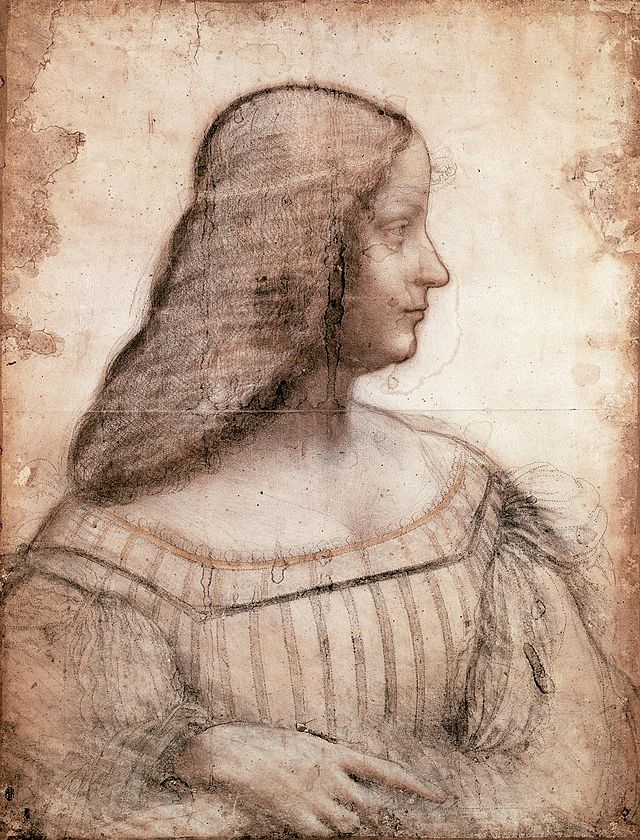

4. Getting started in Antwerp and abroad
Matsys was registered in Leuven in 1491, but the same year he was equally admitted as a master painter in the Guild of St Luke in Antwerp where, at the age of twenty-five, he decided to settle. In Antwerp, as said before, he depicted the choirmaster Jacob Obrecht in 1496, his first known work, and several Virgin and Child devotional paintings.
After that, since the Liggeren (painting guild records) don’t report any information about Matsys activity in the Low Countries for a period of several years, it remains very tempting to imagine Matsys going on an eventual trip to Italy. There, he could have met great masters among which Leonardo da Vinci, who lived in Milan between 1482 and 1499 and returned to Milan in 1506 where he met his pupil Francesco Melzi (1491-1567) who later accompanied him to France. Matsys could also have traveled over the Rhine to Strasbourg or Colmar. He eventually could have traveled to Nuremberg where he could have met Albrecht Dürer which he seems to have known longtime before the latter came to the Netherlands in 1520.
Dürer was sent by his parents to Alsace to be trained in the art of engraving by Martin Schongauer (1450-1491). But when he arrived in Colmar in the summer of 1492, Schongauer had died. From Colmar the artist traveled to Basel, where he made designs for the woodcut illustrations for books and discovered the impressive engravings of Jacob Burgkmair (1473-1531) and Hans Holbein the Elder (1460-1524). He then went to Strasbourg in 1492 where he met and made the portrait of the erudite humanist poet and author Sebastian Brant already mentioned above.
C. Selected Works
1. The Virgin and the Child, Divine Grace and the Free Will
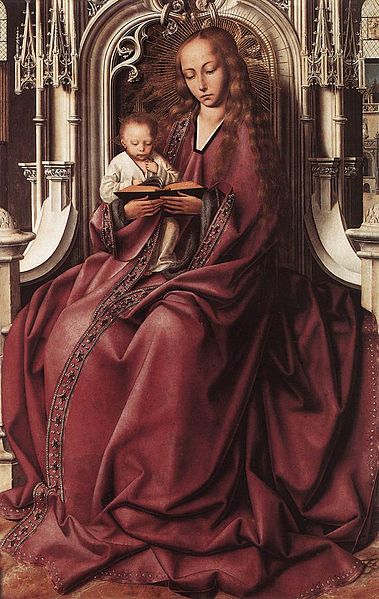

In 1495, Matsys painted a Virgin and Child (left) (Brussels). Even while still very normative, Matsys already “enriches” devotion with less formal scenery of daily life. The child, playfully exploring new physical principles, clumsily tries to turn the pages of a book, while a very serious Virgin sits herself in an elaborated niche of Gothic architecture, probably chosen to fit with the building or house where the work would end up being exposed.
Another Virgin and Child (right) (Rotterdam) of Matsys goes even further in this direction. It shows a quite happy caring young mother with a playful child, underlying the fact that Christ was the son of God but now had become human.
On a display close to the viewer, a loaf of bread and a cup of milk-soup with a spoon, undoubtedly the daily scene for most inhabitants of the Low Countries trying to feed their children.

Another “Madonna and child with the milk soup,” (Brussels) this one painted in 1520 by Matsys’ friend, the painter Gerard David (1460-1523), literally shows a young mother teaching her child that the backside of a spoon is not the best tool to transfer milk soup to one’s mouth.
One outstanding feature of many virgins of these period, be it by Quinten Matsys (Virgin and Child, Louvre, 1529, Paris) or Gerard David (Rest on the flight into Egypt, National Gallery, Washington), is the image of the child trying, with great difficulties, to get a hold on a fruit, be it a cherry or a grape of raisin.

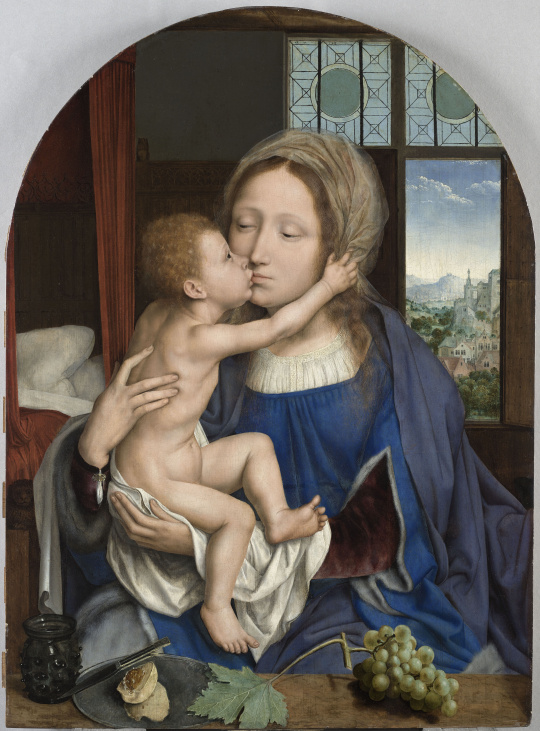
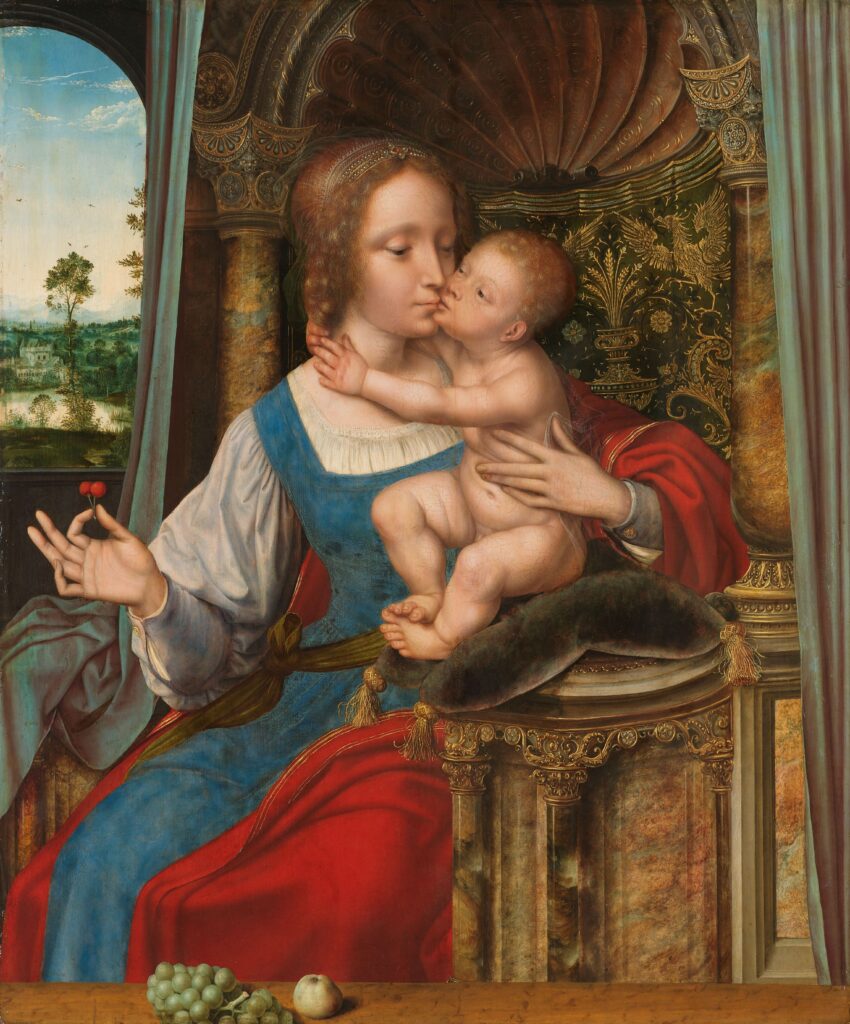
In 1534, in his Diatribe on the Free Will, Erasmus also used this metaphor on the fragile equilibrium to be considered in the proportion between the operations of the free will (which, alone, separated from a higher purpose, can become pure arrogance) and those of divine grace (which alone can be misunderstood as a form of predestination).
To make that point clear with an image, Erasmus paints a very simple metaphor, but of extreme tenderness and beauty:
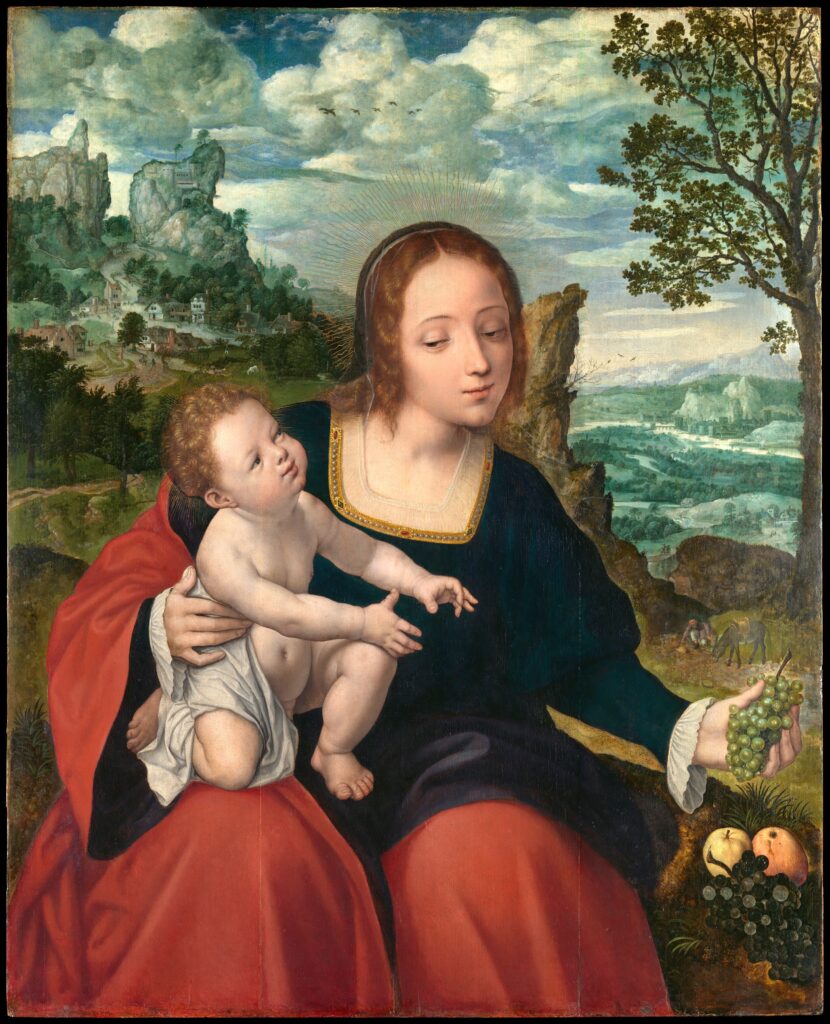
“A father has a child still incapable of walking; it falls; the father pulls him up while the child makes hectic moves and struggles to keep his balance; he shows him a fruit in front of him; the child strives to grab it, but because the weakness of its limbs it would quickly fall if the father did not stretch out his hand to support and guide his walking.
Thus, guided by his father, the child arrives at the fruit that the father willingly puts in his hands as a reward for his effort. The child would never have risen if the father had not lifted him up; he would never have seen the fruit if the father had not shown it to him; he could not have advanced had the father not supported his feeble steps; and he would not have reached the fruit if his father had not put it into his hands.
What will the child claim as his own acts in this case? Hence, one cannot say he did not do anything. But there is no reason to glorify his strength, since he owes to his father everything that he is.”
In short, free will, yes, but without pretending that man can do it alone.
2. Saint Anne Altarpiece
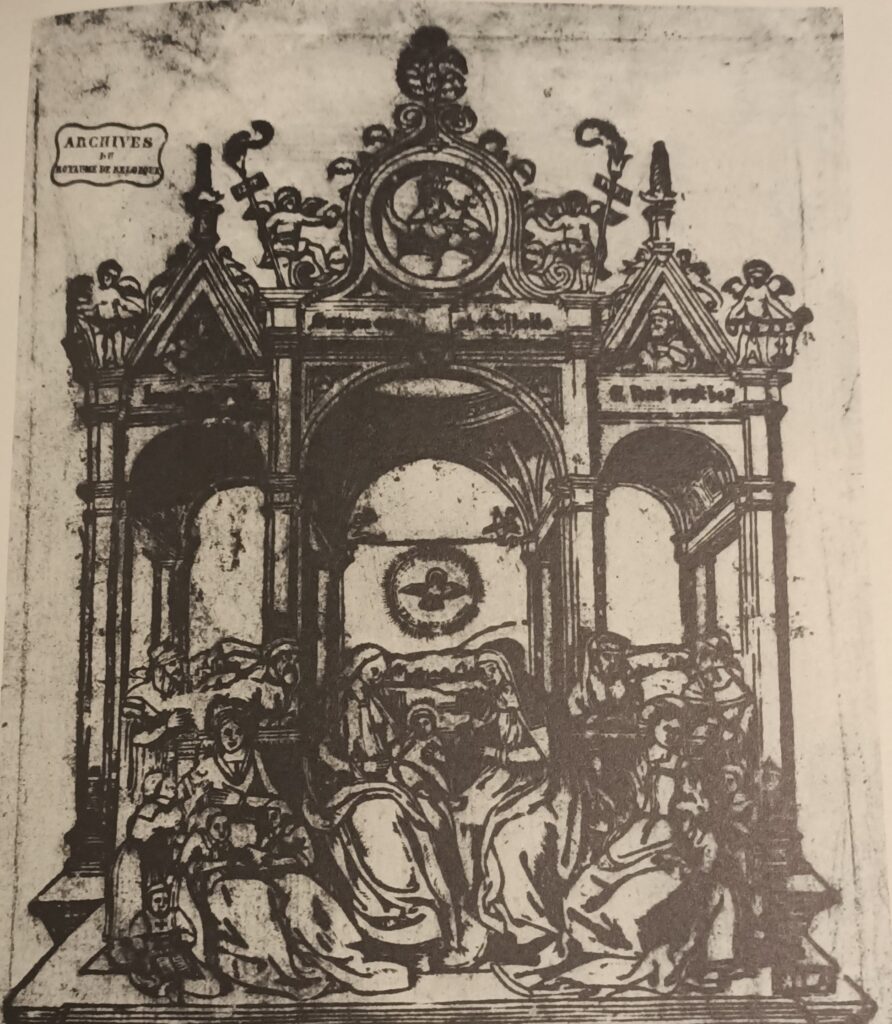
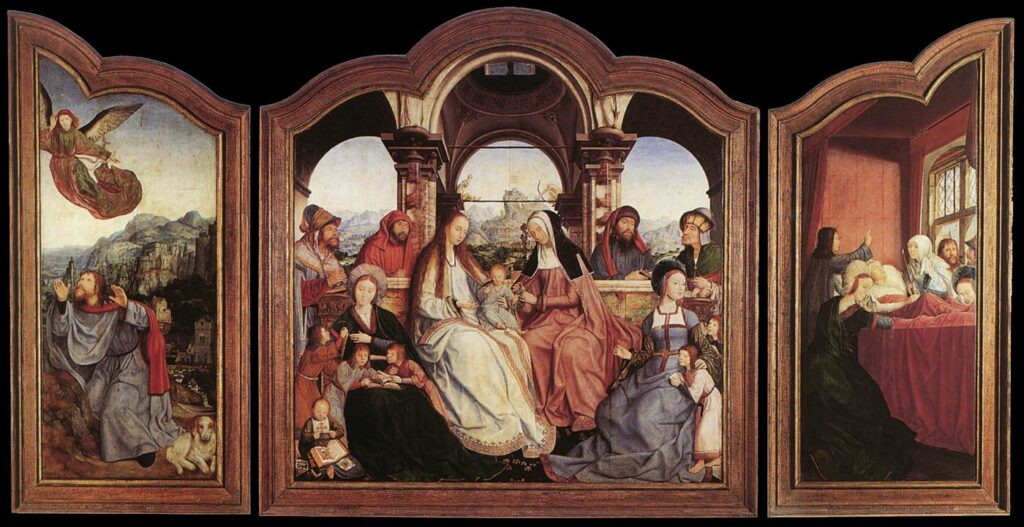
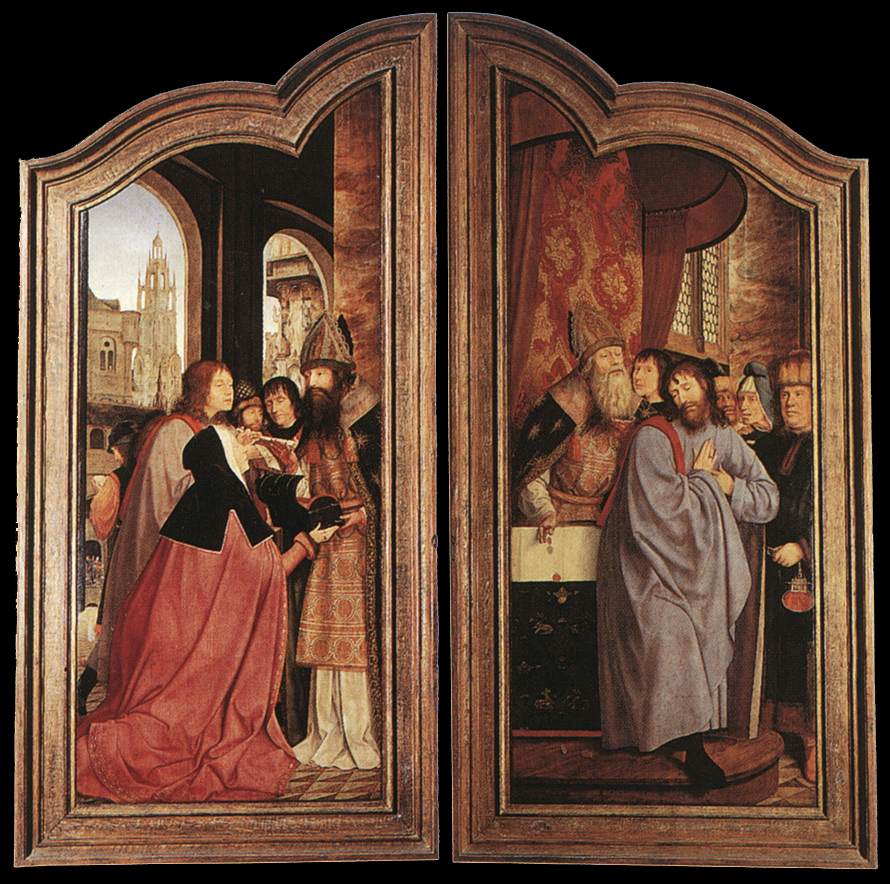
In Antwerp, Matsys’ activity made a major step forward with the first important public commissions for two large triptych altarpieces:
- the beautiful Lamentation quite inspired by Roger Van der Weyden’s Deposition of the cross (Prado, Madrid) ;
- the Saint Anne Altarpiece (1507–1509), painted for the Collegiate Church of St Peter in Leuven and signed “Quinte Metsys screef dit.” (Quinten Metsys wrote this).
The content and narrative of the Saint Anne Alterpiece was of course entirely dictated to the painter by the commissioners willing to decorate their dedicated chapel of the Church. The central panel depicts the history of the family of St Anne – the Holy Kinship – inside a monumental building crowned by a truncated dome and arcades that offer a wide view on a mountainous landscape.
The altarpiece depicts five scenes from the life of Anne, the Virgin’s mother and her husband Joachim. The various members of the saint’s family appear on the central panel. The key event in the life of Anne and her husband Joachim, namely that they will become the parents of the Virgin Mary while they thought themselves incapable of having children, is depicted in the left and right panels of the triptych.
The Chaste Kiss
The Virgin’s “immaculate” conception, depicted as a chaste kiss between the couple in front of the Golden Gate of the Jerusalem city wall, was already a very popular subject matter painted before by Giotto and later by Dürer.
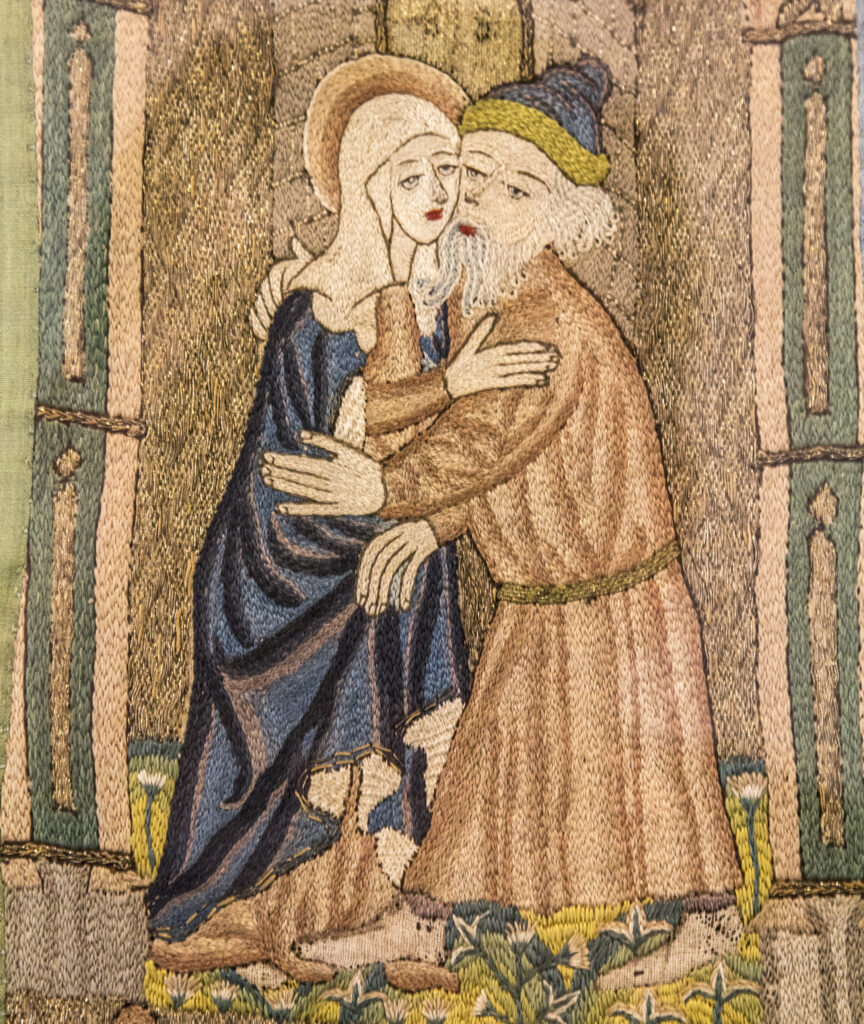


The “chaste kiss” as a metaphor for the immaculate conception of the Virgin, was well received by the public. As a result, it was rapidly transposed to the immaculate conception of Christ himself. Hence, the sudden appearance of paintings showing Mary “kissing” her baby as close as on the lips.

The cycle on the Altarpiece ends with Anne’s death depicted on the inside right panel where she is surrounded by her children and Christ giving his blessings.
Despite the impressive scale and the conventional narrative, Matsys sought to create a more intimate feeling of contemplation. An example of this is the figure of the small cousin of Jesus in the left corner, who playfully gathers beautiful illuminations around him and, now fully focused, tries to read them.
3. A new perspective
In two other articles, I have underscored the fact that both Jan Van Eyck and Lorenzo Ghiberti, were quite familiar with “Arab optics”, in particular the works of Ibn al-Haytham (known by his Latinized name Alhazen).
During the Renaissance, at least two “schools”, after opposing each other, ended up completing each other respecting the best way to represent “space” in art. For one school, centered on Alberti, space could be reduced to a “central” vanishing point, i.e. a purely mathematical geometrical construction. For the other, that of Roger Bacon, Witelo and later Kepler, one had to start from the physiognomy of both eyes and how they produce the image of space in the mind. Van Eyck and Ghiberti used both approaches employing either the one-eyed « cyclopic » Alberti model denounced by Leonardo, or the « bi-focal » Alhazen approach.
Since the cyclopic approach has been decreed to be the only “mathematical” and therefore the only “scientific” way to represent space, the bi-focal approach was slandered as being full of “errors” or purely intuitive and “non-scientific”. Among those accused, most paintings of the “Flemish Primitives”
Now, as mentioned earlier, since 2007, the Ghent Interdisciplinary Centre for Art and Science (GICAS) has been working on a new « catalogue raisonné » of the work of Quinten Matsys.
In 2010, Jochen Ketels and Maximiliaan Martens investigated Matsys’s 1509 Saint Anne Altarpiece and the impressive italianate portico on the central panel to be understood as a visual element integrating the entire work in a three-dimensional wooden frame currently lost (see images above).
“When we directed our photographic lamps to the central panel, they reported, the raking light revealed something that hadn’t been mentioned in the literature at all: incised construction lines in the coffered vaults of the architecture.” Infra-red also brought to light the existence of “a complicated set of drawn construction lines, both freehand as well as aided ones, created with several tools and techniques. Not only has such a complex construction system not been observed in Northern paintings of this period, Matsys must have used a mathematically based procedure to construct the complex loggia.”
(…) “To design the contours of the truncated dome and its decoration, Matsys hardly used any lines, but preferred points” (…) “to the bottom of the capital, Matsys added a few separated letters, presumably a ‘z’, ‘e’ or ‘c’ and ‘l’ or ‘e’. Because of their position close to the element, and the fact that e.g. Piero della Francesca had already used a similar system with numbers and letters in his drawings in De Prospectiva Pingendi (On the perspective of paintings, about 1480), there are reasons to assume a link with the outline or the composition of the column.”

In this respect, it is noteworthy that one of the rare persons, in contact with Matsys at one point or another, which had read and studied Piero della Francesca’s treaty on perspective was none-other than Albrecht Dürer, whose own Four Books on Human Proportion (1528) builds on Piero’s groundbreaking achievements.
The investigators also verified Matsys’ use of the central vanishing point perspective by employing the “cross-ratio” method. Astonished, they demonstrate that “Matsys shows his competence in matters of perspective, equal to Italian renaissance standards” and that his perspective was “very correct, indeed.”
Source: Ghent University publication
Till now, it was taken for granted that the science of perspective only reached the Low Countries after Jan Gossaert’s trip to Rome in 1508, while Matsys’s, showing his masterful and extensive knowledge of science of perspective, started composing this oeuvre as early as 1507.
4. Matsys’ cooperation with Patinir, Dürer and Leonardo
One last note regarding this painting, the mountainous landscape behind the figures, already akin to the typical, eerie landscapes produced years later by Matsys’ friend Joachim Patinir 1480-1524, another badly known giant in the history of painting.
Felipe de Guevara, a friend and artistic assessor to both Charles V and Philip II, mentions Patinir in his Commentaries on Painting (1540) as one of the three greatest painters, alongside Rogier van der Weyden and Jan van Eyck.


A final note on this painting: the mountainous landscape behind the figures already resembles the typical, disquieting landscapes produced by Matsys’s close friend Joachim Patinir (1480-1524), another little-known giant in the history of painting.
Yet Patinir’s authority was no mean feat. Felipe de Guevara, friend and artistic advisor to Charles V and Philip II, mentions Patinir in his Commentaries on Painting (1540) as one of the three greatest painters in the region, alongside Rogier van der Weyden and Jan van Eyck.
Patinir ran a large studio with assistants in Antwerp. Among those under the triple influence of Bosch, Matsys and Patinir are:
- Cornelis Matsys (1508-1556), son of Quinten, who married Patinir’s daughter;
- Herri met de Bles (1490-1566), active in Antwerp, possible nephew of Patinir;
- Lucas Gassel (1485-1568), active in Brussels and Antwerp;
- Jan Mostaert (1475-1552), painter active in Haarlem;
- Frans Mostaert (1528-1560), painter active in Antwerp;
- Jan Wellens de Cock (1460-1521), painter active in Antwerp;
- Matthijs Wellens de Cock (1509-1548), painter-engraver active in Antwerp;
- Jérôme Wellens de Cock (1510-1570), painter-engraver, who, with his wife Volcxken Diericx, founded In de Vier Winden, probably the largest engraving workshop north of the Alps at the time, employing Pieter Brueghel the Elder.
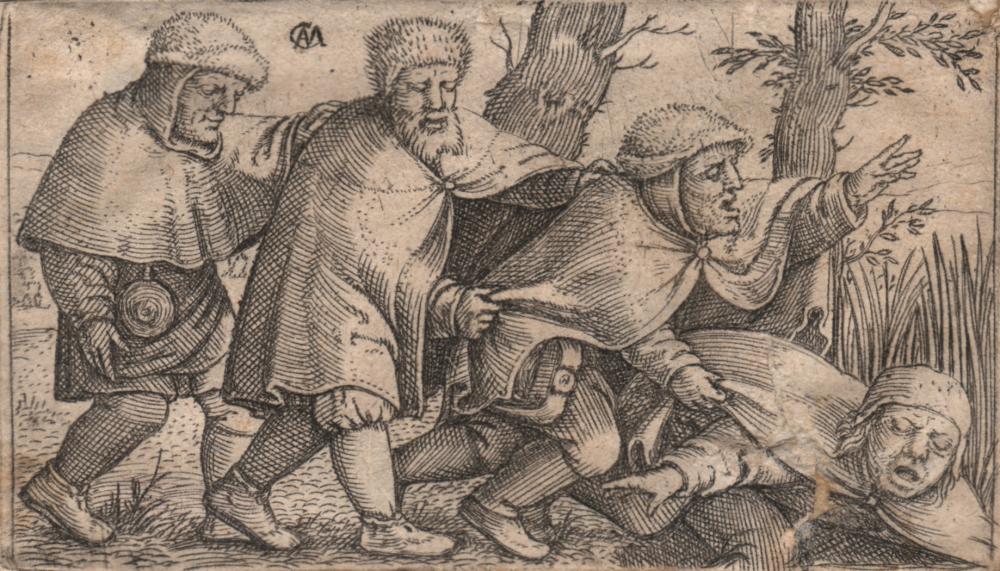
It is generally accepted that Matsys painted the figures in some of Patinir’s landscapes. According to the 1574 Escorial inventory, this was the case for The Temptations of Saint Anthony (1520, Prado, Madrid).
One is tempted to think that this collaboration between friends worked both ways, with Patinir creating landscapes for Matsys’ works and at his request, a reality that somewhat challenges the persistent myth of a Renaissance presented as the cradle of modern individualism.
The fact that Matsys and Patinir were very close is confirmed by the fact that, after Patinir’s untimely death (at age 44), Matsys became the guardian of his two daughters. It’s also interesting to note that Gerard David, who became Bruges’ leading painter after Memling, became a member of the St. Lucas guild in Antwerp in 1515 jointly with Patinir, which gave him legal access to the booming Antwerp art market.
Modern art historians tend to present Patinir as the “inventor” of landscape painting (see my article), claiming that for him religious subjects were mere pretexts for the development of landscapes that were the true protagonists, much as Rubens painted Adam and Eve only because we wanted to paint nudes.
Eventually true for Rubens but dead wrong for Patinir, whose “beautiful” landscapes, as art historian Reindert L. Falkenberg documented in depth, were nothing but a sophisticated sort of deceptive trick of the devil attracting souls to attach themselves to earthly pleasure…

Albrecht Dürer
A unique source of information is Dürer’s diary of his visit to the Low Countries. Why did Dürer come to the Low Countries? One of the explanations is that following the death of his main patron and order giver emperor Maximilian I, the artist came in an effort to get his pension confirmed by Charles V.
Dürer arrived in Antwerp on August 3, 1520 and visited Brussels and Mechelen where he was received by Margaret of Austria (1480-1530), aunt of Charles V, who sometimes lent Erasmus a sympathetic ear, in charge of administering the Burgondian Low Countries as long as Charles was to young.


In Mechelen, Dürer certainly visited the beautiful residence of Hieronymus van Busleyden (1470-1517), soon to become the financial mecenas of the “Trilingual College” launched by Erasmus in Leuven in 1517. Busleyden was a friend of Cuthbert Tunstall (1475-1559), the Bishop of London who introduced him to Thomas More.
While staying with Margaret, Dürer could admire an incredible painting from her collection, The Arnolfini couple (1434) by Jan van Eyck. Margaret had just granted a pension to a Venetian painter, Jacopo de’ Barbari (1440-1515), a diplomat and political exile in Mechelen who painted a portrait of Luca Pacioli (1445-1514), the Franciscan who introduced Leonardo to Euclid and wrote the De Divina Proportiona (1509), illustrated by Leonardo. De’ Barbari was described by his contemporaries, including Dürer, Marcantonio Michiel (1584-1552), and Gerard Geldenhauer (1482-1542).
In 1504, de’ Barbari met Dürer in person in Nuremberg and the pair discussed the canon of human proportions, a core subject of the latter’s research.
Hence, an unpublished draft version of Dürer’s own treatise on the subject reveals that he thought the Italian was holding back on him:
“…I find no one who has written anything about how to make a canon of human proportions except for a man named Jacob, born in Venice and a charming painter. He showed me a man and a woman which he had made according to measure, so that I would now rather see what he meant than behold a new kingdom… Jacobus did not want to show his principles to me clearly, that I saw well”
(as quoted in Levinson Early Italian Engravings from the National Gallery of Art).
By March of 1510 de’ Barbari was in the employ of Archduchess Margaret in Brussels and Mechelen. In January 1511, he fell ill and made a will, and, in March, the Archduchess gave him a pension for life on account of his age and weakness. He was dead by 1516, leaving the Archduchess with his stock of 23 engraving plates. But when Dürer asked her to provide some of de’ Barbari’s writings on human proportion, she politely declined his request.

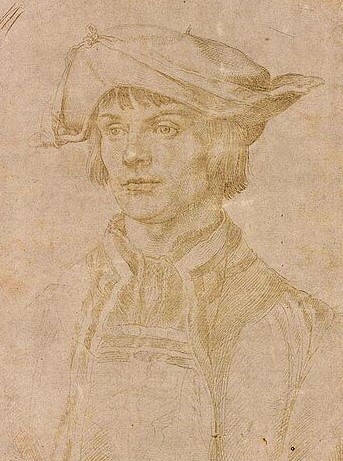

The artist’s diary reveals nevertheless that he was often entertained by his local colleagues. In Antwerp, « I went to see Quinten Matsys in his house, » wrote Dürer in his journal.
In the same city, he makes a portrait sketch of Lucas van Leyden (1489-1533), and the famous portrait of the 93 year old bearded old man who became the model for his St. Jerome.
He met Erasmus at least three times, and sketched a wonderful portrait of him showing mutual complicity. Erasmus placed an order with him since the humanist needed a large number of portraits to send to his correspondents throughout Europe. As his diary indicates, Dürer sketched Erasmus several times in charcoal during these meetings and used them for an engraved portrait of him six years later.
After the death of his wife, Patinir married Johanna Noyts. On 5 May 1521, he invited Albrecht Dürer to his wedding. How and when that friendship started, or if it was just opportunistic, is not known. The master of Nuremberg sketched Patinir’s portrait and called him « der gute Landschaftsmaler » (« the good landscape painter »), creating a new word for what became a new genre.
At the wedding he meets Jan Provoost (1465-1529), Jan Gossaert (of Mabuse) (1462-1533 ) and Bernard van Orley (1491-1542), some of them more attracted by the pomp of the court than by Erasmian humanism. But Provoost’s Death and the Miser (1515) is clearly inspired by Bosch.
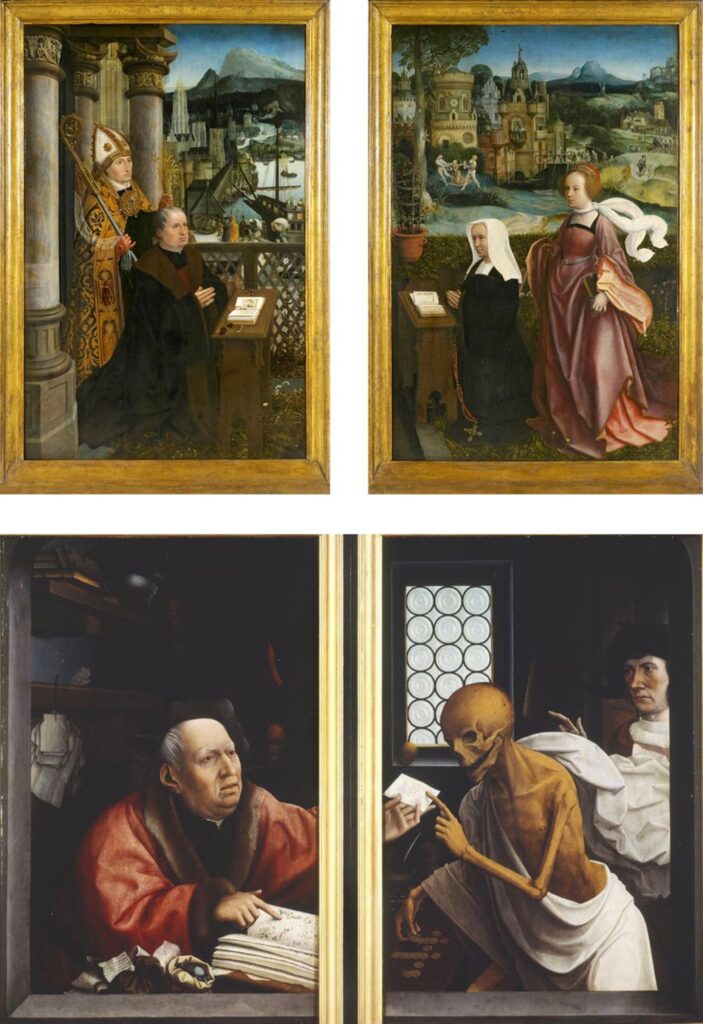
One figure that could have mediated the encounters between intellectuals and craftsmen, was the poet, Latin teacher and philologist Cornelis de Schrijver (Grapheus)(1482-1558), a collaborator of Erasmus printer Dirk Martens. In 1520, he became secretary to the city of Antwerp.
Printers and editors played a key role in the Renaissance as they where the key middlemen between intellectuals, erudites and scholars on the one side, and illustrators, engravers, painters and craftsmen on the other side.
As Dürer himself, he was attracted to the ideas of the Reformation of which they considered both Luther and Erasmus to be leading voices. What is known is that Grapheus bought Dürer a copy of Luther’s De Captivitate (On the Babylonian Captivity of the Church), a must read for anyone having interest in the reform of the Church.
Just as Erasmus and many other humanists, Dürer is also said to have been the guest of Quinten Matsys in the latter’s fabulous house in the Schuttershofstraat, decorated with Italianate decorations (festoons of leaves, flowers or fruit) and grotesques (decorative and symmetric network of lines and figures).

An idealized representation of the Dürer-Matsys encounter (with Thomas More and Erasmus looking on) can be seen in a painting of Nicaise de Keyser (1813-1887) at the Royal Museum of Arts of Antwerp.
Another scene, an 1889 drawing by Godfried Guffens (1823-1901) shows the Antwerp Alderman Gerard van de Werve receiving Albrecht Dürer presented to him by Quinten Matsys.
When Charles V returned from Spain and visited Antwerp, Grapheus wrote a panegyric to welcome his return. But in 1522, he was arrested for heresy, taken to Brussels for interrogation and imprisonment. As a result, he lost his position as secretary. In 1523, he was released and returned to Antwerp, where he became a Latin teacher. In 1540, he was reinstated as secretary of the city of Antwerp.
Quentin Matsys’ own sister Catherine and her husband suffered at Leuven in 1543 for what had become the capital offense of reading the Bible since 1521: he being decapitated, she allegedly buried alive in the square before the church.
Because of their religious convictions, the Matsys children left Antwerp and went into exile in 1544. Cornelis ended his life somewhere abroad.
5. The Erasmus connection


In 1499, Thomas More and Erasmus met in London. Their initial meeting turned into a lifelong friendship as they continued to correspond on a regular basis during which time they worked collaboratively to translate into Latin and have printed some of the works of the Assyrian satirist, Lucian of Samosata (c. 125-180 AD), erroneously called « The Cynic. »
Erasmus translated Lucian’s satirical text The Dependant Scholar and had it send to his friend Jean Desmarais, a Latin teacher at the University of Louvain and a canon at Saint Peter’s Church in that city.
Lucian blasts scholars that sell their soul, mind and body to the ruling oligarchy:
“The elite of Rome are their friends. They dine sumptuously, and call for no reckoning. They are lodged splendidly, and travel comfortably — nay, luxuriously — with cushions at their backs, and as often as not a fine pair of creams in front of them. And, as if this were not enough, the friendship they enjoy and the handsome treatment they receive is made good to them with a substantial salary. They sow not, they plough not; yet all things grow for their use.”…
In a real manifesto against voluntary servitude, Lucian goes after their personal corruption and the real reasons for their selling out:
“And now for the true reason, which you will never hear from their lips. Voluptuousness and a whole pack of desires are what induce them to force their way into great houses. The dazzling spectacle of abundant gold and silver, the joys of high feeding and luxurious living, the immediate prospect of wallowing in riches, with no man to say them nay,— these are the temptations that lure them on, and make slaves of free men; not lack of the necessaries of life, as they pretend, but lust of its superfluities, greed of its costly refinements. And their employers, like finished coquettes, exercise their rigors upon these hapless slaves of love, and keep them forever dangling in amorous attendance; but for fruition, no! never so much as a kiss may they snatch. To grant that would be to give the lover his release, a conclusion against which they are jealously on their guard. But upon hopes he is abundantly fed. Despair might else cure his ardent passion, and the lover be lover no more. So there are smiles for him, and promises; always something shall be done, some favor shall be granted, a handsome provision shall be made for him,— someday. Meanwhile, old age steals upon the pair; the superannuated lover ceases from desire, and his mistress has nothing left to give.”
Source:
http://lucianofsamosata.info/wiki/doku.php?id=home:texts_and_library:essays:the-dependent-scholar
It was through his meeting with Erasmus that Thomas More got introduced to Erasmus’ friend, Pieter Gillis (1486-1533), a fellow humanist and town secretary of Antwerp. It was Erasmus who suggested that Gilles meet Thomas More. The meeting took place in Antwerp in 1515, when More was sent on a diplomatic mission by King Henry VIII to settle some major international commercial disputes.
Gillis, who started as a seventeen year-old proofreader in Dirk Martens print shop in Leuven, met Erasmus in 1504. The humanist gave him the advice to study further and they kept in contact. Printer Martens had edited in Leuven several humanist’s books, most notably those of Denis the Carthusian (1401-1471) and Rudolphus Agricola’s De inventione dialectica (1515) the higher-education manual most widely bought, and used in schools and universities throughout Europe.
Just as More and Erasmus, Gilles was an admirer of the latter’s teacher at the Deventer school of the Brothers of the Common Life, Agricola, a great pedagogue, musician, builder of church organs, a poet in Latin and the vernacular, a diplomat, a boxer and a Hebrew scholar towards the end of his life.
Gillis‘ house in Antwerp was an important meeting place for humanists, diplomats and artists with international allure. Quinten Matsys is also a gladly seen guest. Gilles also recommended the painter Hans Holbein the Younger, who had illustrated Erasmus In Praise of Folly, to the court of England, where Thomas More received him delighted. His brother Ambrosius Holbein (1494-1519), would later illustrate Erasmus’ and More’s Utopia.
6. Thomas More’s Utopia

Gilles shared with More and Erasmus a great sensitivity to justice, as well as a typically humanist sensibility devoted to the search for more established sources of truth. As a matter of fact, he is best known as a character in Utopia, a famous book in whose first pages Thomas More presents him as a model of civility and a humanist who was both pleasant and seriousness:
“I often received during this stay [in Bruges], among other visitors and welcome among all, Pieter Gilles. Born in Antwerp, he enjoys great credit and a prominent position among his fellow citizens, worthy of the highest, for this young man’s knowledge and character are equally remarkable. He is indeed full of kindness and erudition, welcoming everyone liberally, but, when it comes to his friends, with such élan, affection, fidelity and sincere devotion, that one would find few men to compare with him when it comes to the things of friendship. Few also have his modesty, his lack of affectation, his natural good sense, so much charm in conversation, so much wit with so little malice.”

Thomas More’s most famous composition was of course his two-volume work entitled Utopia. It is a depiction of a fictional island that was not ruled by an oligarchy as most western states and empires, but ruled on the basis of the ideas of the good and the just Plato formulated in his dialogue, the Republic.
While Erasmus’ In Praise of Folly called for a reform of the Catholic Church, Erasmus’ and More’s Utopia, satirizing the corruption, greed, cupidity and failings they saw all around them, called for the reform of the State and Economy.
The whole idea of the book came to Thomas More whilst he was staying at the Antwerp residence of Gillis, Den Spieghel, in 1515.
In the first volume, entitled Dialogue of Counsel, it begins with correspondence between More himself and others, including Pieter Gillis. On his return to England in 1516, the English humanist wrote the main part of the work and the first edition was completed and edited by Erasmus and published in Leuven.



The first edition contained a woodcut map map of the island of Utopia, verses by Gillis and the “Utopian alphabet” the latter invented for the occasion, verses of Geldenhouwer, an historian and reformer educated by the Brothers of the Common Life in Deventer and Grapheus, and Thomas More’s epistle dedicating the work to Gillis.
Several years after More‘s and Erasmus’ death, in 1541, Grapheus, with Pieter Gilles, published his Enchiridio Principis Ac Magistratus Christiani.
7. Pieter Gillis and the “Friendship Diptych”
Besides triptychs and religious paintings, Matsys also excelled in portraits. One of the most beautiful works of Matsys is the double portrait of Erasmus and his friend Gillis, painted in 1517. This friendship diptych would act as a “virtual” visit to their English friend Thomas More in London and they approached Quinten Matsys to carry out the two paintings as he was the leading Antwerp painter at that time.
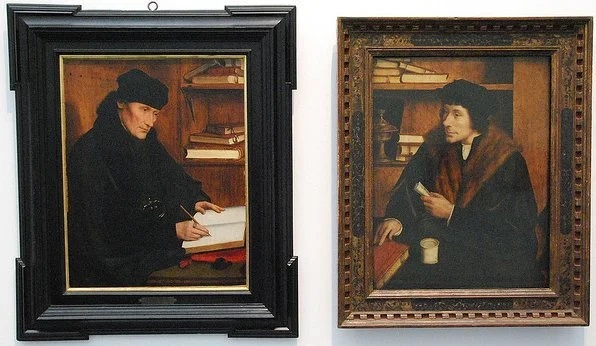
Erasmus’ portrait was the first to be completed because the portrait of Gillis was constantly being delayed due to him falling ill during the sittings. The two men had told Thomas More about the paintings which may not have been a wise move as More constantly queried them as to the progress of the paintings and became very impatient to receive the gift. The two works were finally completed and were sent to More whilst he was in Calais.
Both learned educated men, although they are portrayed on separate panels, are presented in one continuous study area. Erasmus is busy writing and Pieter Gillis points to a book (not yet published) by the humanist, the Antibarbari, while he holds a letter from More in his left hand. The presentation in a study room makes one think of presentations of St. Hieronymus study room, who with his bible translation is an example for all humanists and whose work Erasmus had just published.
If you look closely, in the folds of Erasmus’ cloak you can just make out a purse. It could be that Erasmus wanted the artist to include this in order to illustrate his generosity. Erasmus and Gillis made a point of informing Thomas More that they had split the cost of the painting because they wanted it to be a present from them both. If you look at the two paintings side by side then one can see that Matsys has cleverly continued the bookcase behind the two sitters and this gives the impression that the two men depicted in the two separate panels occupy the same room and are facing each other.
It is interesting to look at the books on the shelves in the background. On the upper shelf of the Erasmus painting there is a book which has the inscription Novum Testament which alludes to Novum Testamentum Graece, the first published edition of the Greek New Testament produced by Erasmus in 1516.
On the lower shelf there is a stack of three books. The bottom tome has the inscription Hieronymus which refers to Erasmus’s edition of St Jerome; in the middle, there is a book with the inscription Lucian and refers to Erasmus and Thomas More’s collaboration in translating Lucian’s satirical Dialogues. The inscription on the book on top of these three is the word Hor, which originally read Mor. The first letter was probably altered during an early restoration, for besides Mor being the first letters of Thomas More’s surname they almost certainly refer to the satirical essays written by Erasmus whilst staying with Thomas More in his London home in 1509 and entitled Encomium Moriae (Praise of Folly). This collection of essays was considered one of the most notable works of the Renaissance.
We see Erasmus writing in a book. This depiction has been carefully thought out for the words one sees on the page paper are a paraphrase of St Paul’s Epistle to the Romans, the handwriting is a careful replication of Erasmus’s own hand, and the reed pen he holds was known to be Erasmus’s favorite writing tool.
Thomas More let his pleasure about these portraits be known in many letters, the paintings being executed, « with such a great virtuosity that all painters from Antiquity pale in comparison », while confessing once he would have preferred his image carved in (far more immortal) stone.
8. The Da Vinci connection (I)


Several paintings clearly prove that Matsys and his circle had extensive knowledge and took some of their inspiration from some of Leonardo da Vinci’s paintings and drawings without necessarily fully comprehending its full and far ranging scientific and philosophical content.
Such is clearly the case in the Virgin and child (1513, Poznan, Poland), literally presenting in front of a Patinir style mountain landscape, the gracious loving pose of Mary embracing the Christ with the latter embracing the lamb, directly a copy of Da Vinci’s Saint Anna and the Virgin (1503-1517), one of the works Leonardo had brought to Amboise in France in 1517.
As said before, it is not known how this “form” came to the attention of the master, be it prints, drawings or other.

A second example can be seen in The Lamentation of Christ (1508–1511), a vast triptych painted for the chapel of the Carpenter Corporation in the Cathedral of Our Lady in Antwerp (Koninklijk Museum voor Schone Kunsten, Antwerp). Both John the Baptist and John the Evangelist, which appear when the triptych is closed, were there patron saints.
The central scene of the open triptych, which is reminiscent of Rogier van der Weyden’s The Descent from the Cross (1435 Museo del Prado, Madrid), is supported by the landscape. The religious drama is considered in detail and harmoniously staged.
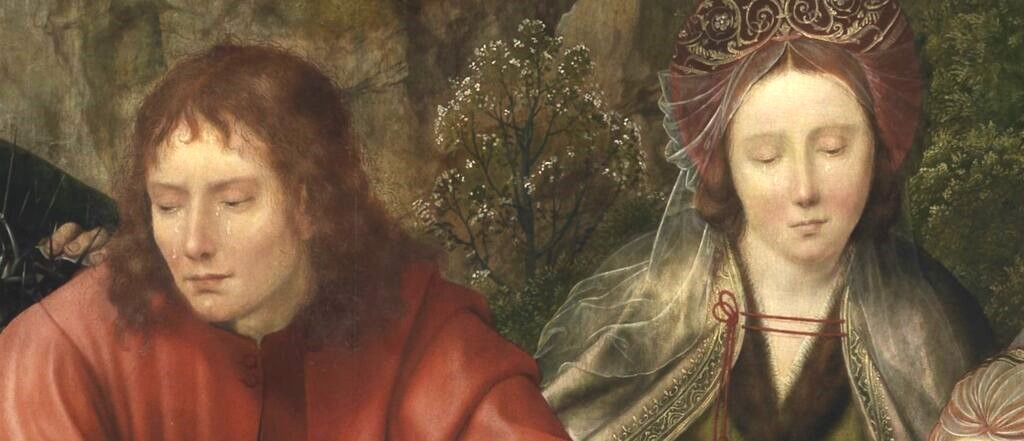
At the same time, Matsys approaches the great importance of the believers for the narration and the description. If the scene is conducive of reflection and prayer. Matsys uses the science of contrast. If some of the figures, especially the oriental heads, could have been inspired by the many exotic faces the painter would have seen around him in the world trade hub that was Antwerp in his days, the graceful faces of those struck with pain and sorrow are extremely beautiful.
In the middle panel, we see not the suffering, but the lament after the suffering. It depicts the moment at which Joseph of Arimathea comes to ask the Virgin for her permission to bury Christ’s body. Behind the central action is the hill of Golgotha, with its few trees, the cross and the crucified thieves.
The left wing panel shows the martyrdom of John the Evangelist and Salome presenting John the Baptist’s head to the Roman Jewish Client King Herod the Great.
The right hand panel is a scene of extraordinary cruelty, depicting St John, his body plunged into a cauldron of boiling oil. The saint, who is naked from the waist up, seems almost angelic, as if he were not suffering. Around him is a crowd of sadistic faces, ugly boors in garish clothes. The one exception to this rule is the figure of a young Flemish boy, maybe a representation of the painter himself, who is watching the scene from above in a tree.
Now the faces of those surrounding St John the Baptist and also the two main figures heating up the cauldron are directly taken or inspired by a drawing of Leonardo called the Five Grotesque Heads.
Flemish irony and humor gave a great welcome to that of Leonardo!
In Leonardo’s case, the faces even seem as breaking up in hilarious laughter, when looking at each other and at the central figure with a crown on his head. The leaves of the crown are not those of laurels to celebrate poets and heroes, but leaves of an oak tree. At that time, the anti-humanist and war mongering pope was Julius II, which Rabelais put in hell. Julius was a member of a powerful Italian noble family, the House of Della Rovere, literally “of the oak tree”…

D. The Science of Erasmian Grotesque
1. In religious painting
The use of grotesque heads expressing the low passions that overwhelm and dominate evil persons was common practice in religious paintings to create contrast of expression.
In 1505, Dürer went to Venice and also to the university city of Bologna to learn about perspective and then journeyed further south to Florence, where he saw the work of Leonardo da Vinci and the young Raphael, and to Rome.

Christ Among the Doctors, 1506, was painted in Rome in five day’s time and reflects the influence of Leonardo‘s grotesques. Dürer was back in Venice early in 1507 before returning to Nuremberg in the same year.

Hieronymus Bosch’s Christ carrying the cross (after 1510, Ghent) is another famous example. Christ’s head is surrounded by a dynamic group of grotesque “tronies” or faces. Was Bosch inspired by Leonardo and Matsys, or was it the other way around?
While the composition may seem chaotic at first glance, its structure is actually very rigid and formal. Christ’s head is positioned precisely at the intersection of two diagonals. The beam of the cross forms one diagonal, with the figure of Simon of Cyrene helping carry the cross at the top left, and with the “bad” murderer to the bottom right.
The other diagonal connects the imprint of Christ’s face on Veronica’s sudarium at the bottom left with the penitent thief, at the top right. He is attacked by an evil charlatan or a Pharisee and an evil monk, a clear allusion by Bosch to the religious fanaticism of his era. The grotesque heads remind us of the masks that are often used in passion plays as well as of Leonardo da Vinci’s caricatures.
By way of contrast, the softly modeled face of Christ is serene. He is the Suffering Christ, who has been abandoned by everyone and who shall triumph over all evil in the world. This representation ties in perfectly with the ideas of the Devotio Moderna.


Quinten Matsys, in his Ecce Homo’s (1526, Venice, Italy) cleary bases his work on the Bosch‘ tradition.
2. Misers, bankers, tax collectors and money-changers, the fight against usury

Directly relevant to Erasmus’ and More’s religious, philosophical, sociological and political critique, and certainly with some relevance for today, Matsys’ denunciation of usury and greed.
Marlier keenly sketches how usurers and speculators became dominant players of Antwerp’s economic life.
« In the sixteenth century, the gradual replacement of the old corporate system by the new capitalist economy went hand in hand with a succession of crises, with the little people suffering most of all. While stock market speculation, currency manipulation and money trading helped build up considerable fortunes, they also impoverished and often ruined craftsmen and peasants. Enriched merchants and financiers took over industry, reducing workers to the status of proletarians. From now on, workers are subject to all the conditions of those who employ them. Wages were no longer respected, and unemployment often plunged families into misery.”
« The economic upheaval was accompanied by financial turmoil caused by the influx of precious metals from America to Spain. Huge banking operations were carried out in Antwerp, which became Europe’s major money market under Charles V. From the third decade of the century onwards, the purchasing power of currencies began to weaken, resulting in a steady rise in prices. Wages, on the other hand, remained static. Men of finance took possession of goods, erected monopolies and even seized land, squeezing tenants mercilessly. These were the new rich, against whom the poor and weak whispered, but whom the Emperor protected, because they alone were able to advance him the funds required by his European policy. Charles V had to submit to the draconian demands of his bankers, and the exorbitant interest payments prompted him to multiply taxes. He discounted the proceeds of future taxes and auctioned off certain treasury offices. The resulting abuses are easy to guess. Taxes were not levied directly by the government, but leased to private tax-collectors, who make themselves odious by their exactions. They have no mercy on the little people, from whom they take what little they have. »
Under those circumstances, notes Marlier, with everybody over their neck into debt and in urgent need for cash, usurers found a fantastic market to prosper.
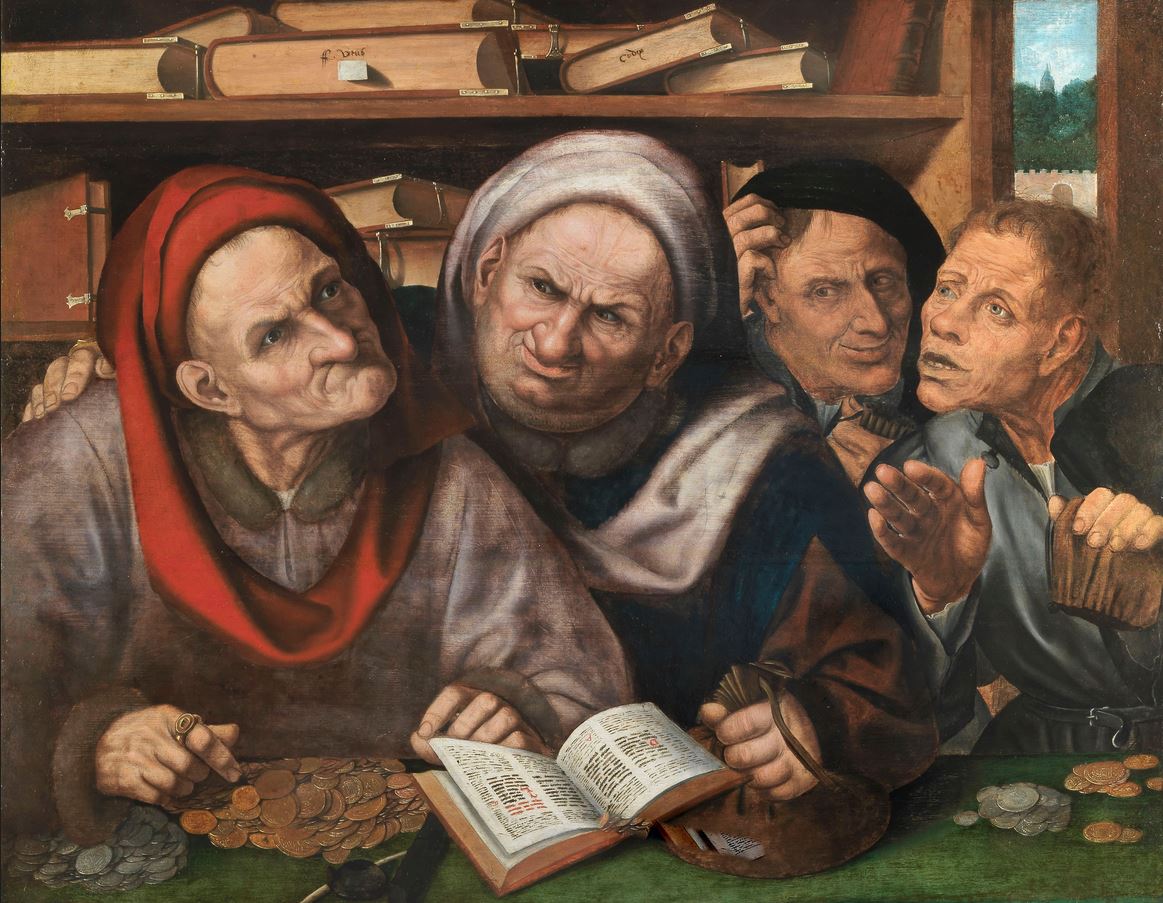
Abroad, the Fuggers and Welsers duly participated in the emerging trade of enslaved people from Africa.

The Fuggers used their mines in Eastern Europe and Germany to produce manillas – metal objects of exchange that have gone down in history as a “slave trade currency” due to their use on the coasts of West Africa. The Welsers, in turn, attempted to establish a colony in what is now Venezuela (Spanish name derived from the Italian Venezziola, “little Venice”, which became Welserland) and shipped more than 1,000 enslaved Africans to America. Meanwhile, in the homes of prosperous Augsburg citizens, enslaved people from India were forced to toil for their “masters”.

According to the official Fugger family website, the story that Anton Fugger threw his promissary notes into the fire in 1530, in front of Charles V, in order to generously waive repayment of loans, is pure fiction. But he did grant the new emperor a proverbial “haircut”. In exchange Charles V abandoned his plans for an “imperial monopoly law” that would have massively curtailed the scope of action of the banking and trading houses in the Holy Roman Empire.
According to Fugger researcher Richard Ehrenberg, the story about Anton didn’t emerge until the late 17th century, presumably to demonstrate his loyalty to the Emperor.
Thomas More and Erasmus exposed the rise of predatory and criminal financial abuse in their book Utopia. Erasmus, while not refusing the rise of modern entrepreneurial capitalism, denounces the abuses of financial greed.
“Christ, he said, did not forbid ingenious activity, but the tyrannical search for profit.”
Civil servants, he argued in his Education of a Christian Prince written for Charles V, should be recruited on the basis of their competence and merit, and not because of their glorious name or social status.
For Erasmus, (speaking through the mouth of Folly):
« The craziest and most despicable of all human classes is that of merchants. Constantly occupied with the vile love of gain, they use the most infamous means to satisfy it: lying lies, perjury, theft, fraud and imposture fill their entire lives. However, they believe themselves to be great people, because their fingers are laden with gold rings, and there are enough flatterers who don’t blush to give them the most honorable titles in public honourable titles in order to catch a piece of such ill-gotten acquisitions. »
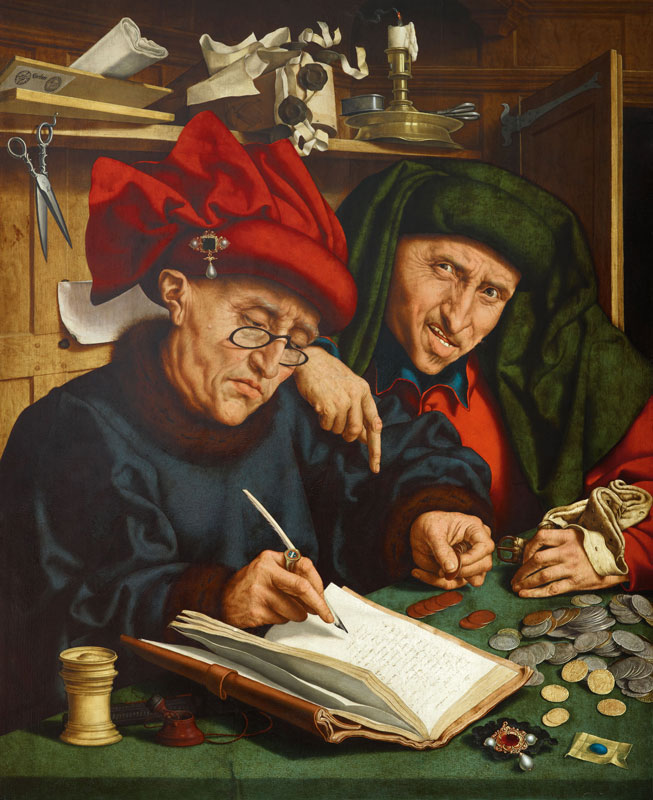
Liechtenstein Collection, Vaduz.
One can, as Silver argues, on the basis of what’s written in the records and the fact that tax collection was outsourced to private individuals, rebrand Quinten Matsys’ painting, often referred to as The Misers, as the more « factually exact » name of Tax Collectors. However, that doesn’t change the fact the subject is precisely what exposes an old Netherlandish proverb of the period:
“A usurer, a miller, a money-changer, and a tax-collector are Lucifer’s four evangelists.”
While the municipal financial officer on the left seems « reasonable » since his face is not “grotesque”, the man sitting behind, in a strange turn of his arm protecting a leather purse, shows the grotesque, ugly face of greed, justified by what he declared and was noted in the records. The complicity between both men is the real ugliness of the story.
Money-changers, admits Silver, often performed the same role as bankers, citing economic historian Raymond de Roover. Moreover, the unrepresented fourth scoundrel, the miller (a target in Bosch’s and Brueghel’s paintings), was often castigated because grain prices became a chronic sore spot in eras of fluctuating commodity prices, as was true in just this period.
Considering the fact that financial looting became dominant after the 1520s, such denunciations of financial greed could not but become very popular. The satirical subject was taken up almost immediately by the painter’s son Jan Matsys (1510-1575), copied close to identically by Marinus van Reymerswaele (1490-1546), and by Jan Sanders van Hemessen (1500-1566).

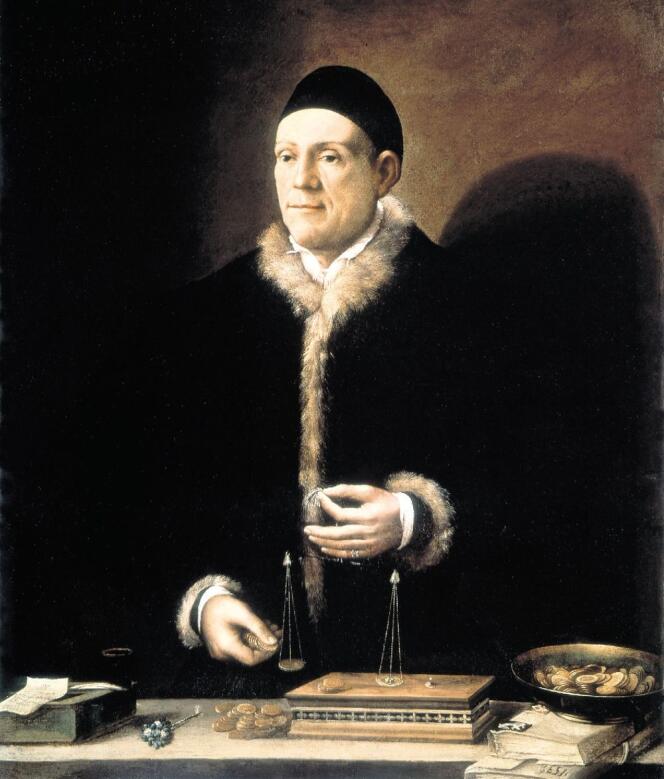
In a more “civilized” version of this metaphor, starting from the same theme, there is Matsys’ famous Banker (or Money Changer) and His Wife (1514, Louvre, Paris).
In a chapter of his opus majus Flemish Primitives entitled The Heirs of the Founders, Erwin Panofsky considers Matsys’ The Money Changer and his Wife to be a “reconstruction” of a “lost work by Jan van Eyck (a ‘painting with half-body figures, depicting a boss doing his accounts with his employee’), which Marcantonio Michiel claims to have seen in the Casa Lampugnano in Milan.”
Once again, it is not a double portrait of a banker of his wife, but a moralizing metaphor. While the banker, who has attached his prayer beads on the wall behind him, is cross-checking if the weight of the metal of the coins correspond to their nominal value, his wife, turning the pages of a religious hour book, throws a sad look at the greedy obsessions of her visibly unhappy husband.
In 1963, Georges Marlier wrote: « The painting in the Louvre has no satirical accent, but reflects a moral concern (…) The edifying intention was underlined by an inscription that appeared on the frame at the time, around the middle of the 17th century, when the painting was in the Stevens collection in Antwerp: ‘Stature justa et aequa sint podere’ (let the scales be just and the weights equal » (Leviticus, XIX, 35).”
The banker has, besides the scales he’s using, attached a pair of them to the wall behind him. For the Christian Humanists, the weight of material wealth is the opposite of that of spiritual richness. In Van der Weyden’s Last Judgment in Beaune, France, the painter ironically shows an angel weighing the resurrected souls, sending the heaviest of them… to hell.
Others speculate the banker’s wife is not completely unaffected by all the coins on the table but the attention of her eyes goes more to the hands of her husband than to the objects on the table. Piety or the pleasure of wealth? A fruit on the shelve (apple of orange), juste above her husband, might be a reference to the forbidden fruit but the estinguished candle on the shelve behind herself recalls the shortness of earthly pleasures.
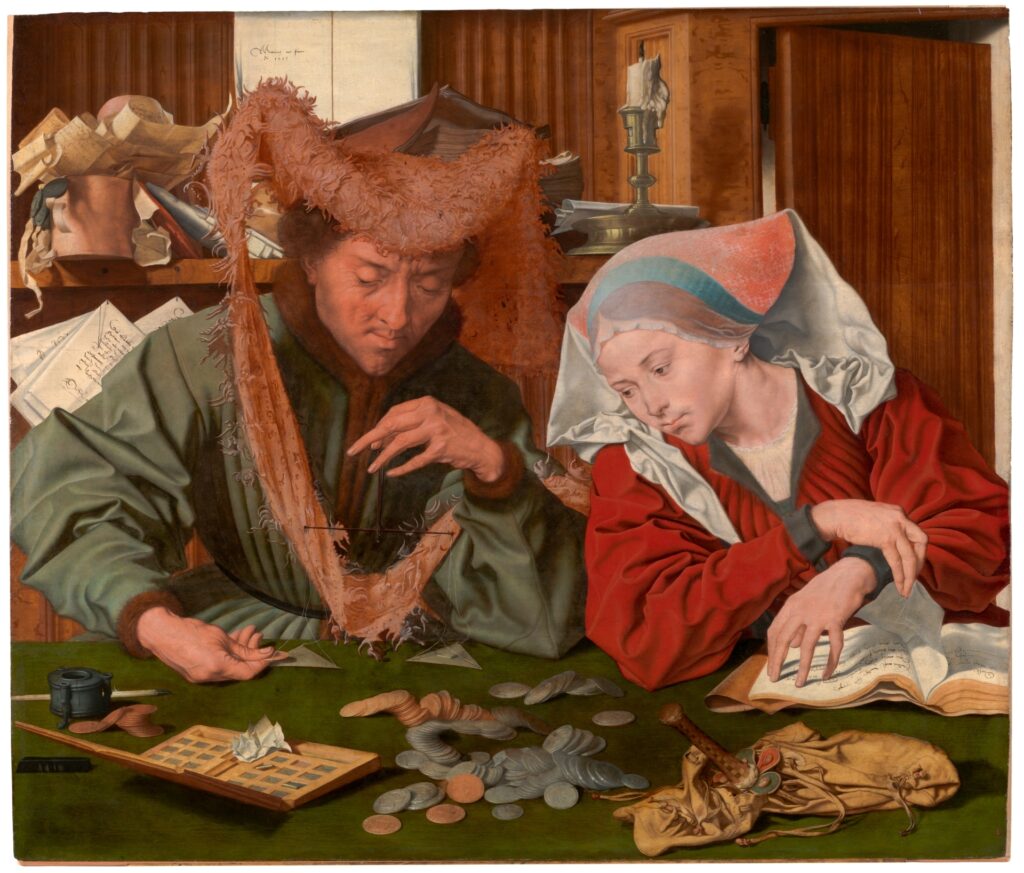
When Marinus van Reymerswaele copies this theme, the woman’s temptation for the money on the table seems even bigger.

The convex mirror (who disappears in the copies made by Matsys’ followers), operating as a “mise en abîme” (a play in the play or a painting in a painting), shows a man (the banker?), reading himself a (religious?) book. The mirror not necesseraly shows some existing real space but can very will represent an imaginary time sequence outside that of the space-time of the main scene. It might show the banker in his future life, free from greed, reading a religious book with great fervor.
While the use of image of convex mirrors (whose optical laws were examined in depth by arab scientists such as Ibn al-Haytham and studied by Franciscans at Oxford such as Roger Bacon) reminds both Van Eyck’s Arnolfini couple (National Gallery, London) and Petrus Christus (1410-1475) Goldsmith in his workshop or Saint Eligius (1449, Metropolitan Museum of Art, New York), with a couple standing behind, Matsys’ painting, is a unique creation of its kind.
In terms of content, the painting could also be related to a common theme at that period, namely The Calling of Saint Matthew.
9 As Jesus went on from there, he saw a man named Matthew sitting at the tax collector’s booth. “Follow me,” he told him, and Matthew got up and followed him.
10 While Jesus was having dinner at Matthew’s house, many tax collectors and sinners came and ate with him and his disciples. 11 When the Pharisees saw this, they asked his disciples, “Why does your teacher eat with tax collectors and sinners?”
12 On hearing this, Jesus said, “It is not the healthy who need a doctor, but the sick. 13 But go and learn what this means: ‘I desire mercy, not sacrifice.’[a] For I have not come to call the righteous, but sinners.”
(Mt 9:9-13)
The above passage is probably autobiographical in that it describes the Matthew’s call to follow Jesus as an apostle. As we know, St. Matthew responded positively to Jesus’ call and became one of the Twelve Apostles.

According to the Gospel, Matthew’s name was originally Levi, a tax collector serving Herod and therefore not very popular. The Romans forced the Jewish people to pay taxes. Tax collectors were known to cheat the people by charging more than required and pocketing the difference. Of course, once Levi accepted the call to follow Jesus, he was pardoned and given the name Matthew, meaning “Yahweh’s gift.”

This theme of course could not but have pleased Erasmus, since it doesn’t insist on punishment but on positive transformation for the better. Both Marinus van Reymerswaele (in 1530) and Jan van Hemessen (in 1536), who copied and were inspired by Matsys, took up the subject as The calling of Saint-Matthew showing Jesus (on the right) calling on a tax collector to abandon his profession. In Van Hemessen’s painting we also see, just as in Matsys’ work, the wife of the tax-collector standing in front, also with her hand on an open book.
The good news is that, till now, the most generally accepted hypothesis as to the meaning of this painting is that it is an allegorical and moralizing work, on the theme of the vanity of earthly goods in opposition to timeless Christian values, and a denunciation of avarice as a cardinal sin.
3. The Da Vinci connection (II)


To sum it up, so far three elements of Matsys’ work have enabled us to establish his deep links with Italy and Leonardo.
1. His expertise knowledge of perspective, in particular that of Piero della Francesca, as demonstrated by the Italian-style marble vault appearing in the Altarpiece of Saint Anne.
2. His use of Leonardo’s grotesque heads, in his Triptych of the Lamentation of Christ.
3. His reworking of the Virgin’s pose from Leonardo’s Saint Anne and the Virgin, in his
Virgin and Child at the Poznan Museum.
How this influence came about remains to be elucidated. Several hypotheses,
which may complement each other, are possible:
1. At an early age, he traveled to Italy (Milan, Venice, etc.), where he may have established direct contact with Leonardo, or with one or more of his pupils.
2. He was able to exchange ideas and prints with other artists who had made such trips
and had established contacts in Italy. Whether Dürer, who had his own contacts in Italy, might have acted as an intermediary is another hypothesis to be explored. Some of Dürer’s anatomical drawings are said to have been made after Leonardo. Jacopo de’ Barbari had painted a portrait of Luca Pacioli, the Franciscan friar who had helped Leonardo to read Euclid in Greek. Dürer had met Barbari in Nuremberg, but, as we saw above, their relationship soured.
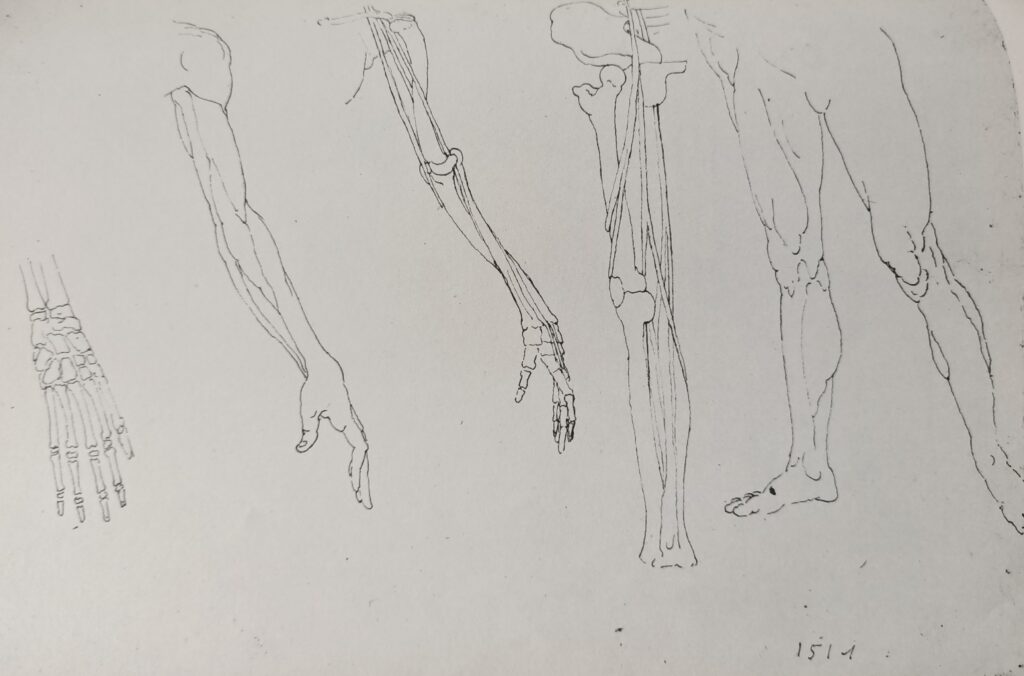

3. He was able to see reproductions made and distributed by Italian and northern artists. Although the original drawings and manuscripts were copied and sold by Melzi, Leonardo’s pupil, after his master’s death in Amboise in 1519, Leonardo’s influence on Matsys appeared as early as 1507.
Leonardo’s work captivated the attention of many in Europe. For example, a life-size replica of Leonardo’s Last Supper fresco was purchased in 1545 by the Norbertine Abbey in Tongerlo, Belgum. Andrea Solario (1460-1524), a pupil of Leonardo da Vinci, is said to have created the work with other artists. Recent research suggests that Leonardo may have painted parts of the replica himself. Professor Jean-Pierre Isbouts and a team of scientists from the Imec research institute examined the canvas using multispectral cameras, which can reconstruct the different layers of a painting and distinguish restorations from the original. According to the researchers, one figure in particular catches the eye. John, the apostle to Jesus’ left, is painted using a special “sfumato” technique. This is the same technique used to paint the Mona Lisa, and one that only Leonardo mastered, says Isbouts.
Similarly, Joos Van Cleve, in the lower part of his Lamentation (1520-1525), repeats the composition of Leonardo’s Last Supper, showing that the image was known to most northern painters.
Moreover, as Silver keenly points out, one of those same heads, a near-profile but reversed from its Leonardo model (the head on the left), reappears for the lustful old man in Matsys’ later “Ill-Matched Lovers » !
The fact that it appears as a mirror image might be the result of Matsys working from a print. The engraver copies the « positive » image, but whet it is prited it appears as « negative ». In other words, as a mirror image of the original.



But also a study by Leonardo of a (not grotesque) head of an Apostle for the Last Supper, shows features close to those used by Matsys.

A life-sized replica of Leonardo’s Last Supper fresco, has been owned since 1545 by the Norbertijnen abbey in Tongerlo. Andrea Solario (1460-1524) a student of Da Vinci, would have created the work with fellow artists.
However, according to recent research, it seems that Da Vinci painted parts of the replica himself. Professor Jean-Pierre Isbouts, together with a team of scientists from Imec research institute, went over the canvas with multispectral cameras, that can reconstruct the different layers in a painting, and distinguish the restorations from the original.
One figure specifically catches the eye, according to Isbouts. John, the apostle on Jesus’ left side is painted with the special ‘sfumato’ technique. This is the same technique used to paint the Mona Lisa, and Da Vinci himself was the only artist that had mastered it, claims Isbouts.

Also Joos Van Cleve, in the lower section of his Lamentation (1520-1525), bases himself on Leonardo’s Last Supper, showing clearly the image was well-known to most painters in the North.

4. The Art of Grotesque per se
Da Vinci’s work on “grotesque heads” dates at least from the early Milan period (1490s) and later when he started looking for a model to paint “Judas” in the Last Supper fresco (1495-1498). Leonardo reportedly used the likenesses of people in and around Milan as inspiration for the painting’s figures. When the painting was nearly finished, Leonardo still was lacking a model for Judas. It’s said that he loitered around jails and with Milanese criminals to find an appropriate face and expression for Judas, the fourth figure from the left and the apostle who ultimately betrayed Jesus. He advised artists to always carry a notebook to draw people around town, “quarreling or laughing or fighting”. He took note of outlandish faces on the piazza, because in another note recommending sketching strangers, he adds:
“Of monstrous faces I shall say nothing because they naturally stay in the mind.”
When the convent’s prior complained to Ludovico Sforza of Leonardo‘s « laziness » as he wandered the streets to find a criminal to base Judas on, Leonardo responded that if he could find no one else, the prior would make a suitable model… While the painting was being executed, Leonardo’s friend, the mathematician Lucia Pacioli, was around and in contact with the master.
For the Italian scientist, always keen to explore the dynamic of contrasts of nature, exploring the ugly was not only a game but inherent to the role of the artist:
“if the painter wishes to see beauties that would enrapture him,” Leonardo wrote in his notebook, « he is master of their production, and if he wishes to see monstrous things which might terrify or which would be buffoonish and laughable or truly pitiable, he is their lord and god.”
Italian scholar Sara Taglialagamba notes that the grotesque, being abnormal or “out of norm”, in the works of Leonardo is conceived as “the opposite of balance and harmony” but “not to oppose beauty.”
The deformities that connote Leonardo’s figures affect both men and women, are present in the young and the old (although on the latter they are concentrated for the most part), spare no portion of the body, and are often combined to give the subjects even more bestial appearances.
Geometry of Human Proportions
From his side, Dürer, now accused of « racial profiling » took very seriously the issue of understanding human proportions, considered, especially with the discovery of Vitruvius book De Architectura, as to offer the key to the right proportions for human architecture and urban planning. According to Vitruvius, « Beauty is produced by the pleasing appearance and good taste of the whole, and by the dimensions of all the parts being duly proportioned to each other. »
Dürer therefore measured all parts of the human body to establish harmonic relations among them. The variations in the proportions of faces and bodies, he concluded, obey the variations generated by geometric projections. They don’t change in terms of harmony but will appear different and even grotesque when projected from a different angle.


Both Leonardo and Dürer, and later Holbein the Younger in his painting The Ambassadors (1533, National Gallery, London), became masters in the science of “anamorphoses”, I.e. geometrical projections from tangent angles making an image hardly recognizable for the viewer looking straight to the plane surface while the image can be understood when viewed from that surprising angle.
Having such masters of “serious” beautiful forms as Leonardo or Matsys suddenly engaging in outrageous cartoon drawing may look disturbing, while it should not. All cartoons are based on metaphorical thinking and so is all great art.
Renaissance art is often assumed to be orderly and reassuring but these faces succeed the uncompromising polemics of the gargoyles of the cathedral builders, the “monsters” in the margin of so many illuminated manuscripts that Bosch invited on the forefront and anticipate those of Rabelais, Goya and Ensor. They are so distorted and out of the habitual norm that they get the label “grotesque” but they also make us smile when we, reluctantly and even with some anger, accept to look down on our own imperfections or those of our beloved we prefer not to see. We are not the icons we take for real that we see in the magazines.
In Erasmus’ Praise of Folly, the narrator (Folly personified), first identifies, among many other accomplishments, its own leading role in making things work that with pure logic, reason and intellect would fail, such as the ridiculous acts required to achieve human reproduction.
Hence, says Folly, “if all were thus wise you see how soon the world would be depopulated, and what need there would be of a second Prometheus, to plaster up the decayed image of mankind?”
Folly, with satirical irony, claims it is doing a great job helping especially older people to refuse dying off like animals:
“Of my gift it is, that you have so many old Nestors everywhere that have scarce left them so much as the shape of a man; stutterers, dotards, toothless, gray-haired, bald; or rather, to use the words of Aristophanes, « Nasty, crumpled, miserable, shriveled, bald, toothless, and wanting their baubles, » yet so delighted with life and to be thought young that one dyes his gray hairs; another covers his baldness with a periwig; another gets a set of new teeth; another falls desperately in love with a young wench and keeps more flickering about her than a young man would have been ashamed of. For to see such an old crooked piece with one foot in the grave to marry a plump young wench, and that too without a portion, is so common that men almost expect to be commended for it.
But the best sport of all is to see our old women, even dead with age, and such skeletons one would think they had stolen out of their graves, and ever mumbling in their mouths, « Life is sweet; » and as old as they are, still caterwauling, daily plastering their face, scarce ever from the glass, gossiping, dancing, and writing love letters. These things are laughed at as foolish, as indeed they are; yet they please themselves, live merrily, swim in pleasure, and in a word are happy, by my courtesy.”
5. The metaphor of the “Ill-matched Lovers”

If Erasmus will blast with biting irony the corruption and madness of the Kings, Popes, Dukes and Princes, he will also expose with uncompromising irony the corruption affecting the common man, for example older men dropping their spouses to hook up with younger women, a practice, says Folly, “grown so common, that it is become the a-la-mode of the times.”
The pairing of unequal couples has a literary history dating back to antiquity when Plautus, a Roman comic poet from the 3rd–century BC, cautioned elderly men against courting younger ladies.
The « grotesque marriage » comes straight from the satirical literature, such as the above mentioned Ship of Fools (1494) of Sebastian Brant, which in its 52nd chapter tackles the « marriage-for-money » theme.
Besides In Praise of Folly, Erasmus dedicated in 1529 a colloquium to this theme titled The Unequal Marriage. (Box)
The Unequal Marriage
Gabriel. Do you know Lampridius Eubulus ?
Petronius. Yes ; there is not a better nor happier Man in the City.
Ga. Well, and do you know his Daughter Iphigenia too?
Pet. You have mention’d the very Flower of the Age.
Ga. She is so; but, do you know who she’s married to?
Pet. I shall know when you have told me.
Ga. She is married to Pompilius Blennus.
Pet. What, to that Hector, that us’d to talk Folks to Death in cracking of his bullying Tricks?
Ga. To the very Man.
Pet. He has been for a long Time very noted in this Town, for two Things chiefly, i.e. Lying and the Mange, which has no proper Name to it, tho’ indeed it has a great many.
Ga. A very proud Distemper, that won’t strike Sail to the Leprosy, the Elephantine Leprosy, Tetters, the Gout, or Ringworm, if there was to be an Engagement between them.
Pet. So the Sons of Esculapius tell us.
Ga. What Need is there, Petronius, for me to describe to you a Damsel that you are very well acquainted with ? altho’ her Dress was a great Addition to her native Beauty. My Petronius, you would have taken her for a Goddess, had you seen her. Every Thing in her and about her was graceful. In the mean Time out comes our blessed Bridegroom with his Snub-Nose, dragging one Leg after him, but not so cleverly neither as the Switzers do ; itchy Hands, a stinking Breath, heavy Eyes, his head bound up with a Forehead-Piece, and a Running at his Nose and Ears. Other People wear their Rings on their Fingers, but he wears his on his Thighs.
Pet. What was in the Mind of the Lady’s Parents, to join such a Daughter to a living Mummy?
Ga. I can’t tell, except it was with them, as it is with many more, that have lost their Senses.
Pet. It may be he was very rich ?
Ga. He is very rich indeed, but it is in the Debts he owes.
Pet. What greater Punishment could they have inflicted upon the Maid, if she had poison’d her Grand-Fathers and Grandmothers, both of the Father’s and Mother’s Side ?
Ga. Nay, if she had scatter’d her Water upon the Grave of her Parents, it would have been a Punishment bad enough to have oblig’d her but to have given a Kiss to such a Monster.
Pet. I am of your Mind.
Ga. I look upon it a greater Piece of Cruelty, than if they had stripp’d their Daughter naked, and expos’d her to Bears, Lions, or Crocodiles : For these wild Beasts would either have spar’d her for her exquisite Beauty, or put her out of her Pain by a quick Dispatch.
Pet. You say right : I think this is what would have become Mezentius himself, who, as Virgil tells us,’bound dead Bodies to living ones, Hands to Hands, and Mouths to Mouths.’ But I don’t believe Mezentius himself would have been so inhuman as to have bound such a lovely Maid to such a Carcass as this : Nor is there any dead Body you would not chuse to be bound to, rather than to such a stinking one ; for his Breath is rank Poison, what he speaks is Pestilence, and what he touches mortifies.
Source: US Archives
This Erasmian theme of the “Ill-matched Lovers,” became quite popular. According to art historian Max J. Friedlander, Matsys was the first to propagate this theme in the Low Countries.
Matsys depicts this theme by showing an older man besotted by a younger, beautiful woman. He gazes at her adoringly, not noticing that she is stealing his purse. In reality, the grotesque ugliness of the man, blinded by his lust for the young woman, corresponds to the ugliness of his soul. She, blinded by her greed, appears superficially as a “nice” girl, but in reality is abusing the naive fool. But the viewer rapidly finds out that the money she steals from the old fool, goes directly in the hands of the jester standing behind her and whose face expresses a combination of both lust and greed. In final analysis, that’s the moral, all the gain goes neither to him nor to her, but to foolishness itself (The Jester). A situation reminiscent of Bosch’s 1502 painting The Conjurer.
Matsys’ painting raises the issue of “Mutually Assured Corruption,” where, just as in geopolitics, both sides think they are winning at the expense of the other in a zero sum game. From that standpoint, the “moralistic” lesson here goes far beyond simple cheating among partners.
As said before, what were considered so far as “sins” (lust and greed) by the Church, became a subject of laughter for the humanist with the painting offering a “mirror” allowing viewers to self-reflect and to improve their own character.

The theme already appears in a copper engraving of Dürer in 1495, with the girl opening her hand to get money from his purse into her own.

And in 1503, Jacopo Barbari painted a similar subject, An old man and a young woman. (Philadelphia)
Cranach the Elder, who made a trip to Antwerp in 1508, and was visibly inspired by the Leonardo style grotesques of Matsys, started mass producing paintings on this theme (including the use of Matsys reworked grotesque of Leonardo!), clearly answering the growing demand of protestant Germany, a production continued by his son Cranach the Younger.
http://eve-adam.over-blog.com/2016/03/les-couples-mal-assortis-lucas-cranach.html




Cranach will make variations on the theme, often reducing the theme to only “lust” leaving “greed” (money grabbing) out of the picture.
Of course, the uglier and the older the man, and the younger and the more beautiful the lady, the more the resulting contrast creates an emotional impact by underscoring the shocking character of the event. Cranach will playfully inverse roles and show an old woman with her maid, seducing a handsome young gentleman.

Quinten Matsys’ son, Jan Matsys, will do his own variation on the theme, adding a new social dimension, that of poor families using their daughters as bait to trap older rich gentlemen whose wealth and money will allow the family to have a living, a theme also Goya took up.
Already in one of Cranach’s versions, the rich man has in front of him a loaf of bread on the table. But what strikes in Jan’s version, is the mother, standing behind the old foolish man, staring at the bread and the fruits on the table. If the greed and the lust remain real, Jan points to a given context which cannot simply be laughed away.
Among the many other artists that painted this theme one has to note Hans Baldung Grien (1485-1545), Christian Richter (1587-1667) and Wolfgang Krodel the Elder (1500-1561).
None of them reproduced completely the pun crafted by Matsys and most loyal to the real spirit of Erasmus, that of foolishness coming out on top winning the game, a truly laughable situation ! The Triumph of Folly!
Also here, for the face of the old foolish man, Matsys was influenced by sketches of grotesque heads by Leonardo.
6. Leonardo’s baby, the “Ugly Duchess”

This allows us now to introduce maybe the most outrageous painting ever made, alternatively called the Old ugly woman or The ugly Duchess. Oceans of ink have been thrown on paper to speculate on her identity, her “disease” (Paget’s disease), her “gender”, most of the time to turn the eye of the viewer to a literal, “fact-based” explanation rather than enjoying and discovering the “mental” metaphor the artist paints, not on the panel, but in the mind of the viewer.
The painting has to be analyzed and understood with its pendant – an accompanying painting – which depicts an old man whose attention she solicits. In a surprise move, as a first approach, one can say that Matsys inverts the common gender roles here, since what we see is not an old man trying to seduce the girl, but an old woman trying to attract a rich old man.
–First, there is the old lady, whose physical state is ultimate decrepitude, who desperately tries to seduce an old rich man. Just as Domenico Ghirlandaio’s Old man and young boy (1490, Louvre, Paris), the person’s outside appearance prompts the audience to consider the relationship between internal and external beauty.
“Externally, writes one observer, based on her exquisite dress, jeweled accessories, and budding flower, this woman was theoretically beautiful. However, her internal beauty is reflected in her exaggerated and displeasing physical appearance.”
Once again, the obvious literary influence is Erasmus‘s essay In Praise of Folly (1511), which satirizes women who « still play the coquette », « cannot tear themselves away from their mirrors » and « do not hesitate to exhibit their repulsive withered breasts. » The woman’s clothes are rich. She is dressed to impress, including bulbous headgear that heightens her unusual features. Defying the modesty expected from older women during the Renaissance, she is wearing a low-cut, uncovered, and tightly laced bodice that emphasizes her wrinkly cleavage.

Her hair is concealed in the horns of a heart-shaped bonnet, over which she has placed a white veil, secured by a large, bejeweled brooch. However fine her attire, by the time this panel was painted in the early sixteenth century her clothes would have been many decades out of date, reminding those of Van Eyck’s portrait of his wife Margaret a century earlier, prompting laughter rather than admiration.
Her headdress had by then become an iconographic shorthand for female vanity, its horns compared to those of the devil or at best those indicating she was betrayed by her lovers (cornuto). She appears to be selling herself on her looks, for she holds a flower, often an advert for sex work in Renaissance art. It was in the tragic fate of the rose that the flight of time, and with its physical decay, found its most alarming illustration. Whether fresh or fragile, the rose, while calling for immediate pleasure, seems to protest that death is just around the corner.

To identify the woman, several names are put forward. In the seventeenth century, the painting was misidentified as a portrait of Margarete Maultasch (1318-1369), who, having separated from her first husband Jean Henri de Luxembourg, remarried Louis 1er, Margrave of Brandenburg, after a thousand and one twists and turns, culminating in the couple’s excommunication by Clement VI. A complicated story in turbulent times, which earned Margarete the nickname “mouth-bag” (big mouth), or “prostitute” in Bavarian dialect. The problem is that other portraits of Margarete are known to exist, in which she appears most comely…
Defamed as the “ugliest woman in history,” she gained the nickname “The Ugly Duchess,.” In the Victorian era, this picture (or one of its many versions) inspired John Tenniel’s depiction of the Duchess in his illustrations of Lewis Carroll’s Alice’s Adventures in Wonderland (1865). This entrenched the moniker and turned this figure into an icon for generations of readers.

–Second, the old Man, whose fur-trimmed robe and visible gold rings, while not as demonstrably archaic or absurd as the costume of the Woman, nonetheless suggest conspicuous wealth, and his distinctive profile echoes the familiar profile of Europe’s leading merchant-banker of the fifteenth century, the late Cosimo de’ Medici of Florence.
After having played a key role as a patron of the arts and a backer of the Renaissance and the Council of Florence, became quite a disgusting figure. It has to be noted that in 1513 the warrior pope Julius II, a strong enemy of Erasmus, died and Giovanni di Lorenzo de’ Medici became pope Leo X.
The figure has also been compared to the lost portraits of the early fifteenth century of Duke Philip the Bold of Burgundy.
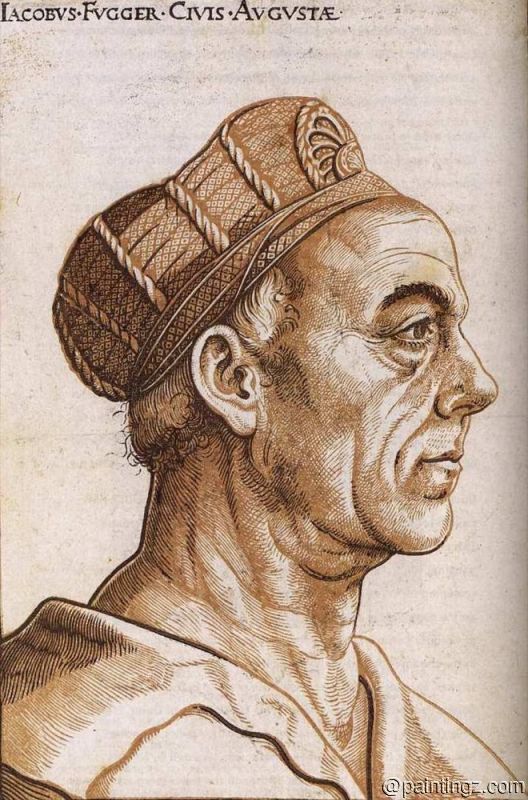
But if one takes a second look, and forgets the woman’s breasts, the viewer realizes that her face is that… of an ugly man. Maybe the whole undertaking was a political statement and the faces were those of real people whose identity we’ve not yet discovered. They might be some hated politicians or theologians of those days, selling out one to the other in an elan of greed and lust. Maybe the old ugly prostitute was a reference to fugger banker Jacob the Rich, the eternal bankroller of the increasingly bankrupt Vatican ? For the moment, let’s accept we just don’t know.
The Bohemian artist Wenceslaus Hollar (1607-1677) saw Matsys double portrait and made in 1645 an engraving of it, adding the title “King and Queen of Tunis, invented by Leonardo da Vinci, executed by Hollar.”

In periods of carnival, when people were allowed to do away with the rules of society for a couple of days, at least in the Low Countries and the Northern Rhine area, people had a lot of fun by shifting roles. Putting things upside down, poor peasants could dress up as rich merchants, laymen as clergymen, thieves as policemen, male as female and one and all the other way around.
The original concept of this metaphor seems to have come from Leonardo, who made a tiny sketch of an ugly woman, eventually a prostitute, remarkably with the horn bonnet and a tiny flower planted between her breasts, exactly the same attributes, metaphors and symbols employed later by Matsys in his work.



Leonardo’s pupil Melzi and other students or followers, as they did with many other of Leonardo’s sketches, seem to have copied Leonardo’s work and, amused, counter-posed the horny woman with a greedy, wealthy Florentine merchant. Did Melzi share or sell his sketches to others?


Various amusing versions of the theme are scattered around the world and figure in private and pubic collections.
Another sketch, either by Leonardo himself of his followers, shows a wild grotesque man with his hair raising up his head, with a series of grotesque looking scholars, including one looking like Dante! Leonardo, of course, who always signed his writings with the words “man without letters,” was a mere craftsman and never taken serious by those scholars Lucian exposed for having sold out to the establishment.
All these elements that what Matsys did was nothing “bizarre” or “extravagant,” but as someone sharing a “culture” of grotesque faces whose variations could be used to express the metaphorical puns of the humanist culture.
But of course, what made his old man and woman impact so huge, was the fact that what for Leonardo were nothing but rapid sketches in a notebook, became with Matsys life-size frighteningly hyper-realistic representations!
In the Queen’s Windsor Collection, there exists a red chalk drawing of the woman nearly exactly as she appears in Matsys work.

Untill very recently, historians were convinced that Quentin Matsys had “copied” this drawing of around 1490 attributed to Leonardo which he enlarged to produce his oil painting. “So Leonardo designed this unique person, even to the wrinkled bosom emerging from her dress. All Matsys did was enlarge her in oils,” it is said.
However, recent research suggests it could have been the other way around! Either Melzi, or Leonardo himself, could have made the red chalk drawing starting from Matsys painting, either from a direct view, prints or reproductions. An Italian copying a Flemish painter, can you imagine?
Leading expert Susan Foister, Deputy Director and Curator of Early Netherlandish, German and British Painting at The National Gallery, London, who was also the curator of the museums 2008 exhibit “Renaissance Faces: Van Eyck to Titian,” told The Guardian at that time : « We can now say with confidence that Leonardo – or, at least, one of his followers – copied Matsys’s wonderful painting, not the other way around. This is a very exciting discovery. »
Foister said they had discovered that Matsys made amendments as he went along, suggesting he was creating the image all by himself rather than copying a model. Also, in the two Leonardo copies, the forms of the body and clothes are oversimplified and the woman’s left eye is not in its socket. « It was always assumed that a lesser known northern European artist would have copied Leonardo and it has not really been thought that it could have been the other way round, » said Foister. She added that both artists were known to be interested in ugliness and exchanged drawings « but credit for this masterful work belongs to Matsys ».
Source: The Guardian
E. Conclusion
The conclusion writes itself. The “Seven Capital Sins” which More and Erasmus tried to eradicate five centuries ago have become the very axiomatic “values” of today’s “Western” system.
At the ground level, people are offered the “freedom” to sell out to lust, envy, greed, sloth, gluttony, etc. — all of this packed as “diversity”, on condition they don’t call into question the speculative financial and war policies that is imposed on them from a tyrannical oligarchy on the top. And those pretending to defend « european » and « judeo-christian » values will lack any credibility if they don’t take up the fight against financial oligarchism so clearly exposed by Thomas More and Erasmus.
Erasmus would turn around in his grave if he knew that his name is mainly associated with a scholarship offered by the EU for pupils willing to study in other EU member states. As Belgian professor Luc Reychler has suggested, such scholarships should include a mandatory training period in Erasmus’ thoughts and especially his advanced concepts of peace building.
In short, to make a new renaissance a reality, we have to free our fellow citizens from fear. While unaware about such real dangers as nuclear war, they live in fear of threats they have been brought to imagine. For those like us longing for peace, time has come to take Erasmus’, Leonardo’s and Matsys’ vision of “good laughter,” very, very, very seriously.
I end here with following rebus:
« D » stands for « The »; the world stands for « World »; the foot, in flemish « voet », meaning also « feeds », and the « vedel » (Vielle) also means « many », following by two happy fools. The phrase therefore reads: « The World Feeds Many Happy Fools! » And you are one of them! But don’t tell! Mondeken Toe!

Selected biography
- Bosque, Andrée, Quinten Matsys, Arcade Press, Brussels, 1975;
- Marlier, Georges, Erasme et la peinture flamande de son temps, Editions van Maerlant, Damme, 1954;
- Kwakkelstein, Michael W., Heads in Histories;
- Ketels, Jochen and Martens, Maximiliaan, Foundations of Renaissance, Architecture and Treatises in Quentin Matsys’ S. Anne Altarpiece (1509);
- Silver, Larry, Matsys and Money, The Tax Collectors Rediscovered, Journal of Historians of Netherlandish Art;
- De Bruyn, Eric; Op de Beeck, Jan, De Zotte Schilders, ‘t Vliegend Peerd, Mechelen, 2003;
- Revel, Emmanuelle, Le prêteur et sa femme de Quinten Metsys, Collection Arrêt sur oeuvre, Service culturel, Action éducative, Louvre, 1995;
- Vereycken, Karel, How Erasmus Folly Saved Our Civilization, Schiller Institute, Washington, 2005;
- Vereycken, Karel, Dirk Martens, L’imprimeur d’Erasme qui diffusa les livres de poche, Artkarel.com, 2019;
- Vereycken Karel, Albrecht Dürer’s fight against Neo-Platonic Melancholia, Artkarel, 2007;
- Vereycken Karel, Leonardo da Vinci, painter of movement, Fidelio, 2002;
- Vereycken Karel, With Hieronymus Bosch, On The Track of the Sublime, Schiller Institute, 2007;
- Vereycken, Karel, The Greek Language Project, Plato and the Renaissance, Artkarel, 2021;
- Vereycken Karel, Petrarch, Pieter Brueghel and the « Triumph of Death », Artkarel, 2020;
- Vereycken Karel, The Egg Without Shadow of Piero della Francesca, Fidelio, 2000;
- Vereycken, Karel, Patinir and the Invention of Landscape Painting, Artkarel, 2008;
- Vereycken Karel, Devotio Moderna, Brothers of the Common Life, the cradle of Humanism in the North, Artkarel, 2011;
- Vereycken, Karel, Jan Van Eyck, a Flemish Painter using Arab Optics, Artkarel, 2006;
- Vereycken, Karel, Avicenna, Ghiberti and the invention of perspective during the Renaissance, Artkarel, 2022.
- More? Index of Renaissance studies (EN, FR, IT, DE, NL, ES, etc.)
Posted in Comprendre, Etudes Renaissance | Commentaires fermés sur Quinten Matsys and Leonardo — The Dawn of The Age of Laughter and Creativity
Tags: allegory, Antwerp, artkarel, Barbari, Boccaccio, caricature, creativity, Della Francesca, dessin, Dirk Martens, Dürer, Eloge de la folie, Erasme, folie, good laughter, Gossaert, gravure, grotesque, In Praise of Folly, irony, Karel, Karel Vereycken, Laughter, Leuven, Massys, Matsys, metaphor, Metsijs, Metsys, painting, Patinier, Patinir, peinture, Petrarch, Piero, Quinten, Quinten Matsijs, renaissance, symbol, Thomas More, Utopia, Vereycken
Posted by: Karel Vereycken | on février 26, 2020
Les bâtisseurs de la cathédrale d’Anvers
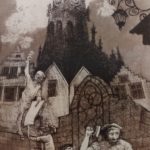
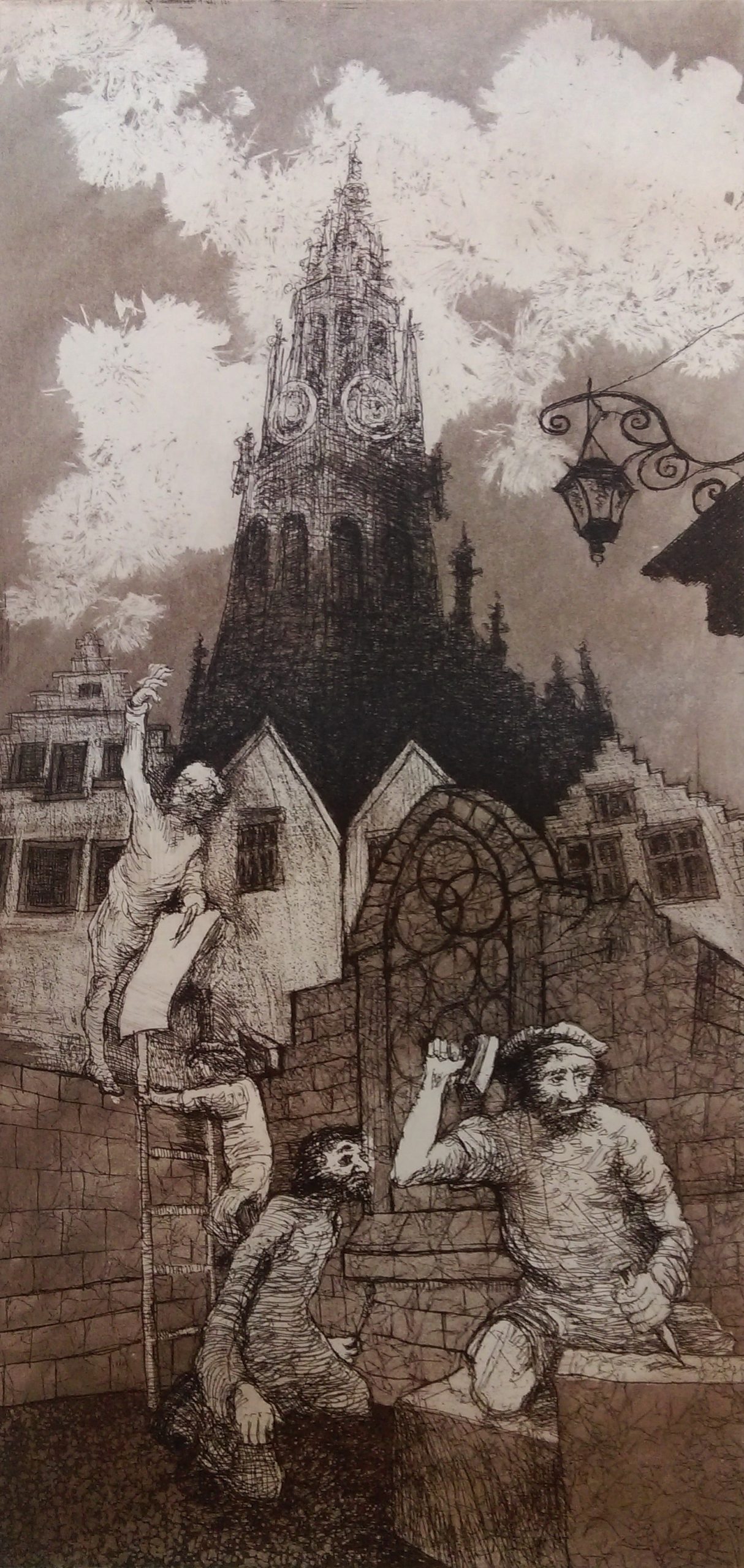
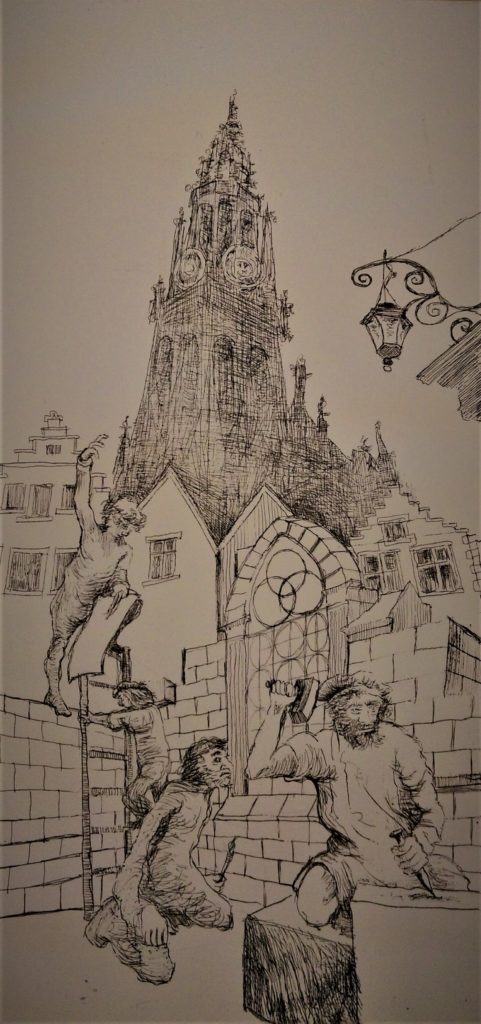
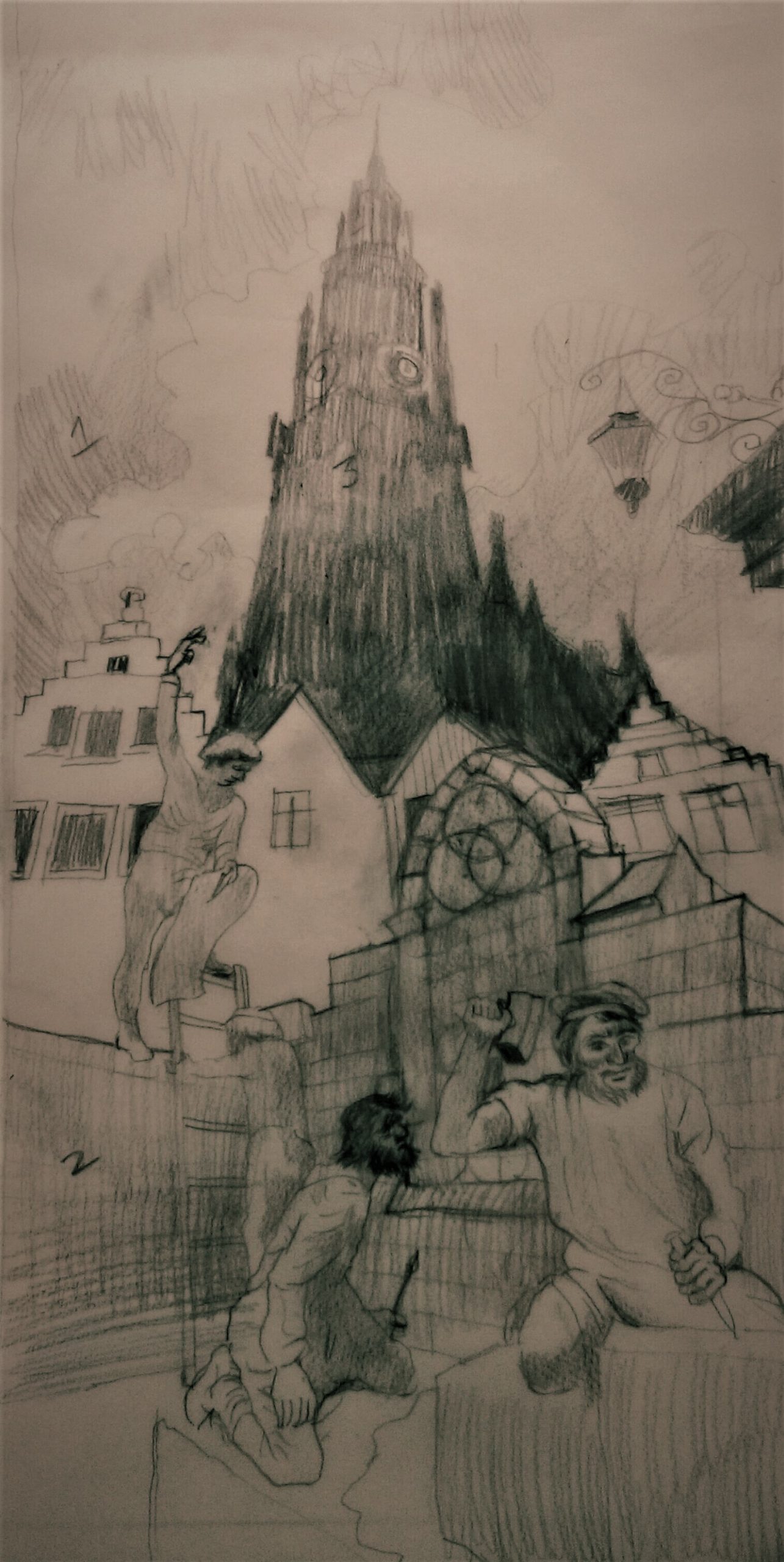
Posted in Créer, Gravure, Toutes les oeuvres | No Comments »
Tags: antwerpen, anvers, Appelmans, arkarel, art, cathédrale, dessin, étude, Handschoenmarkt, Jef Lambeaux, Karel, Karel Vereycken, kathedraal, Notre Dame, perspective, Quinten Matsijs, Vereycken